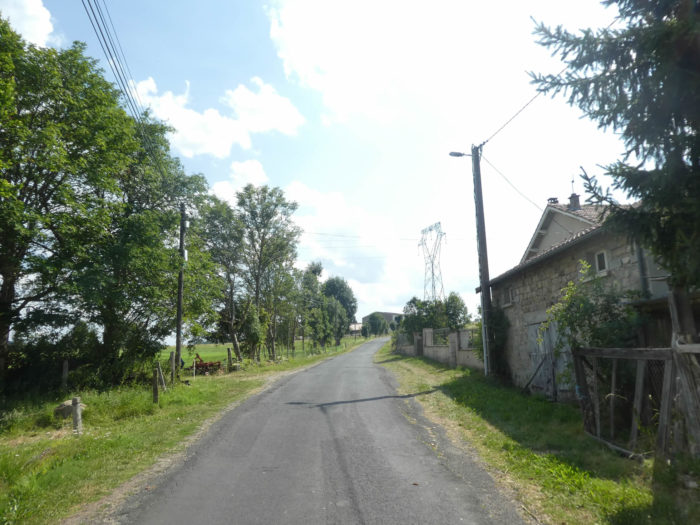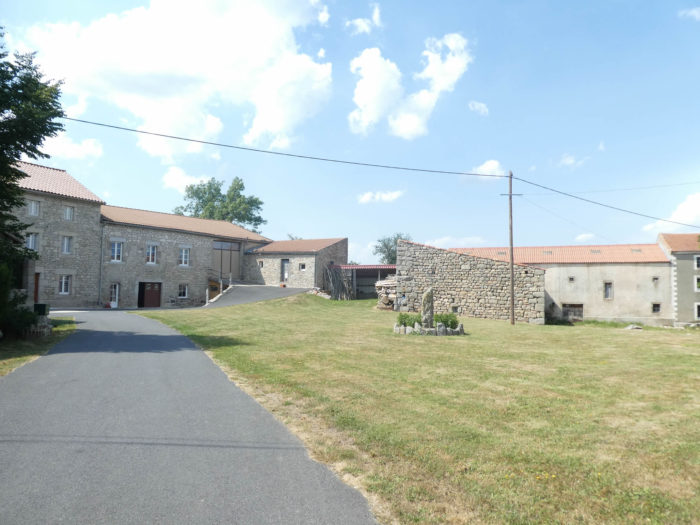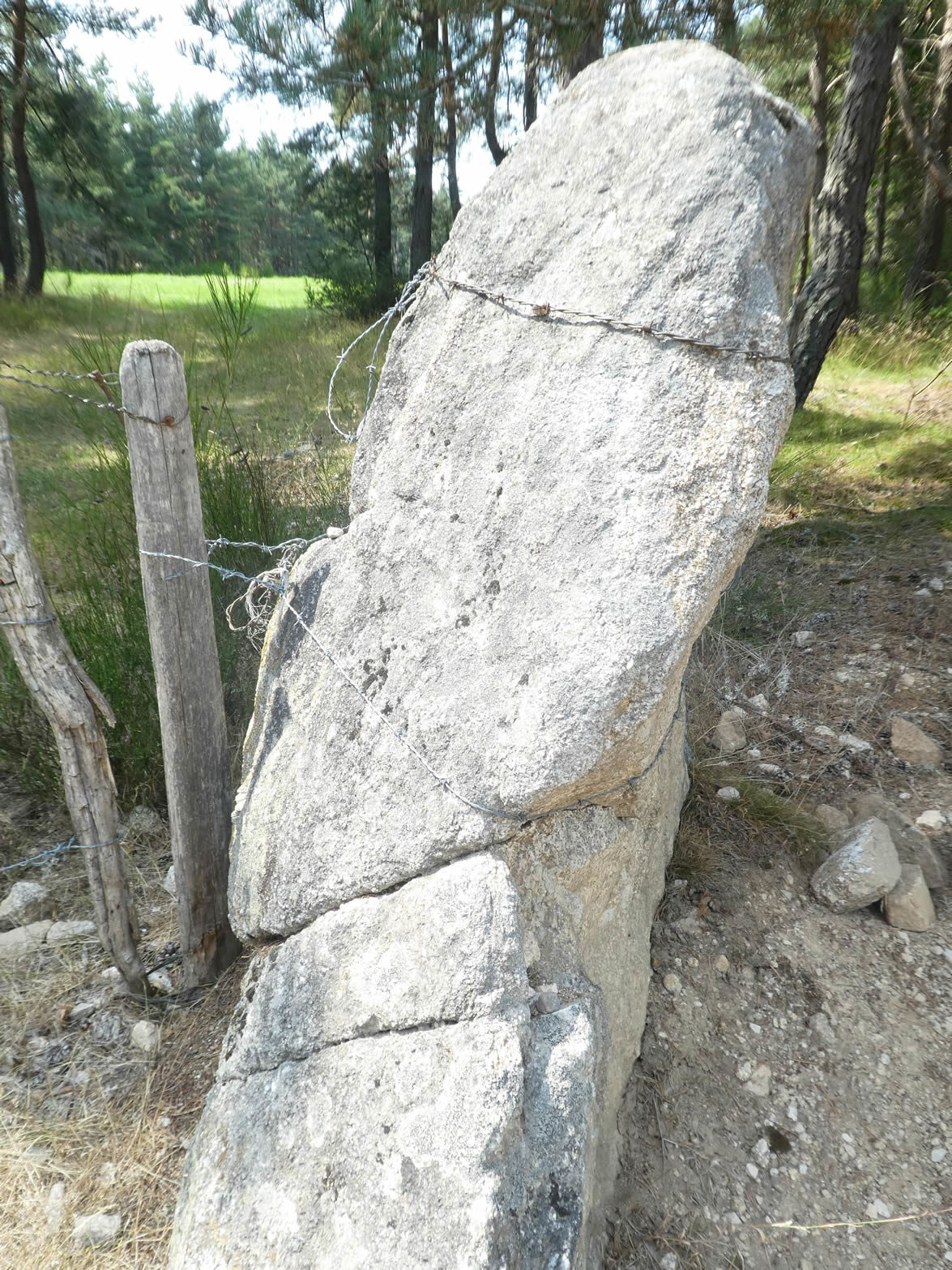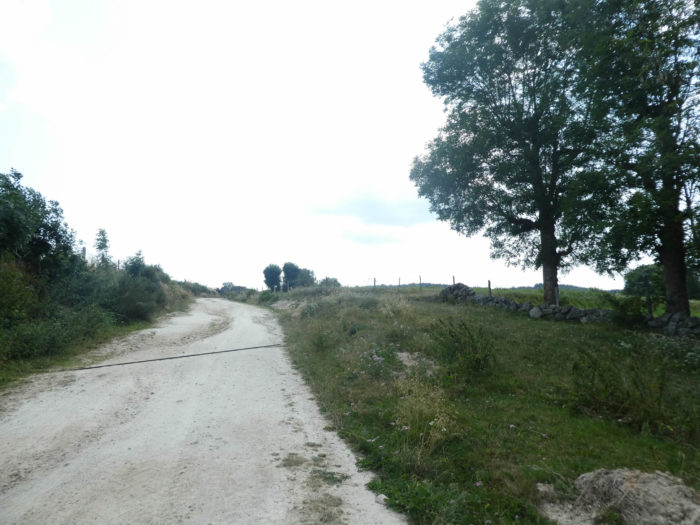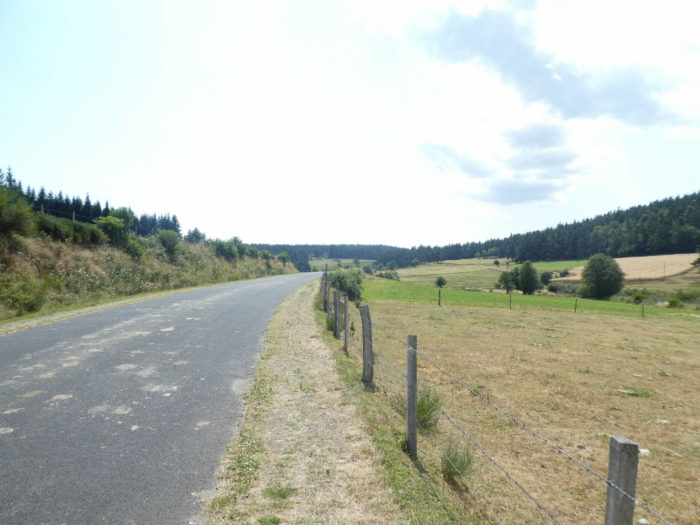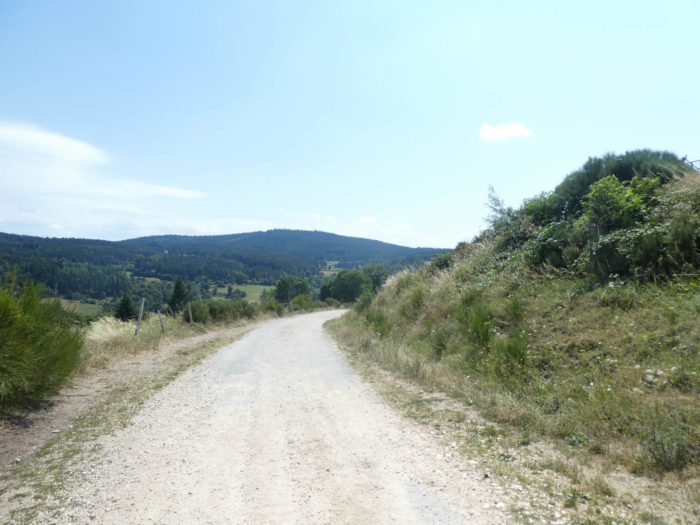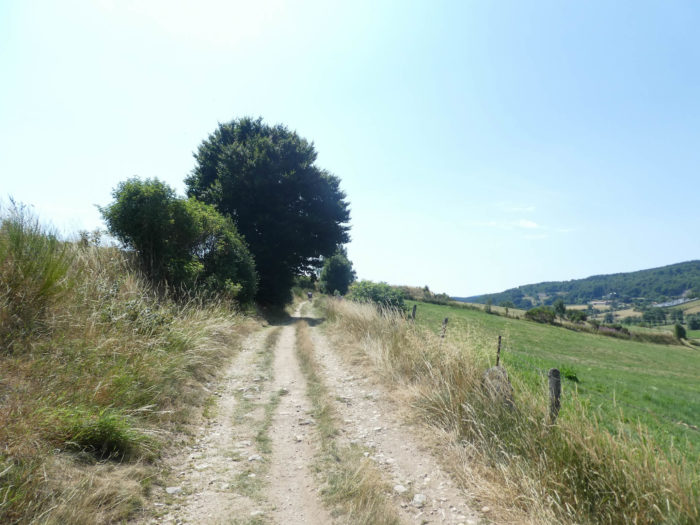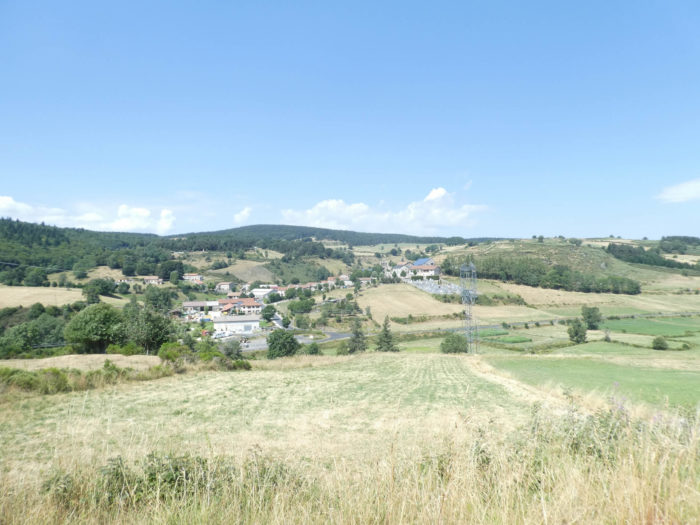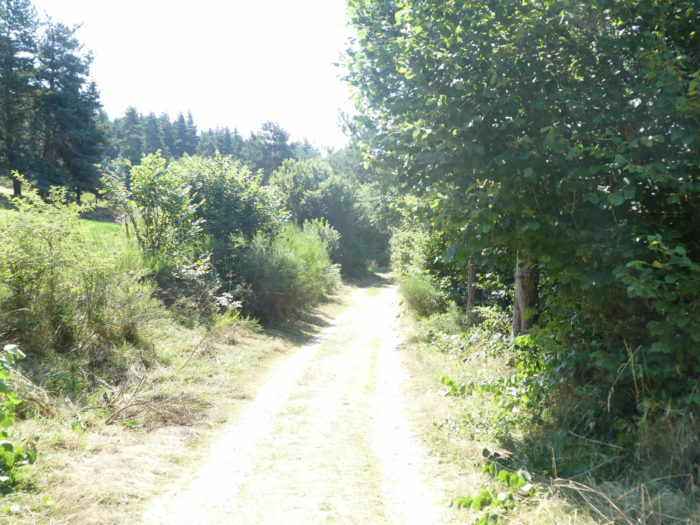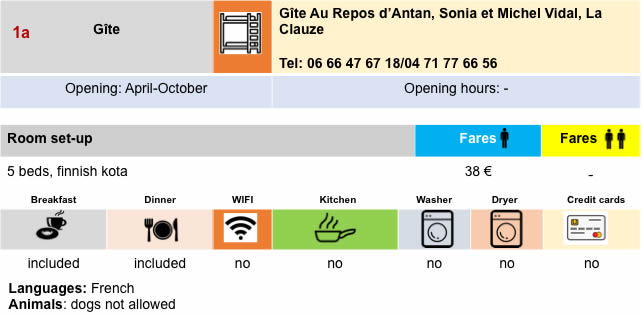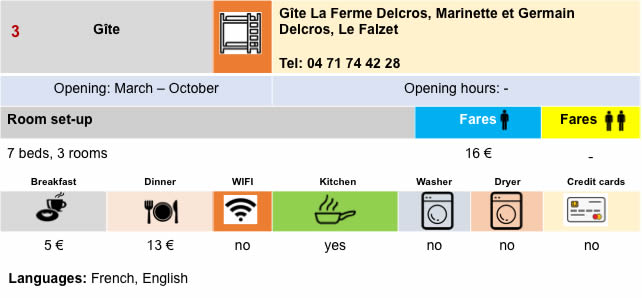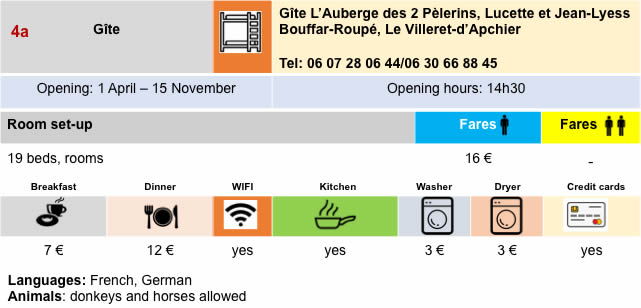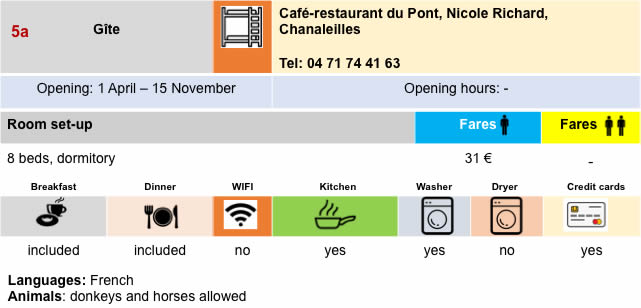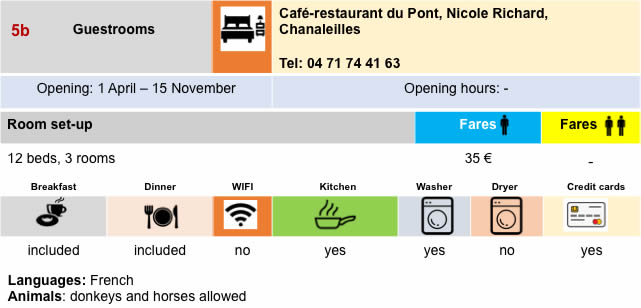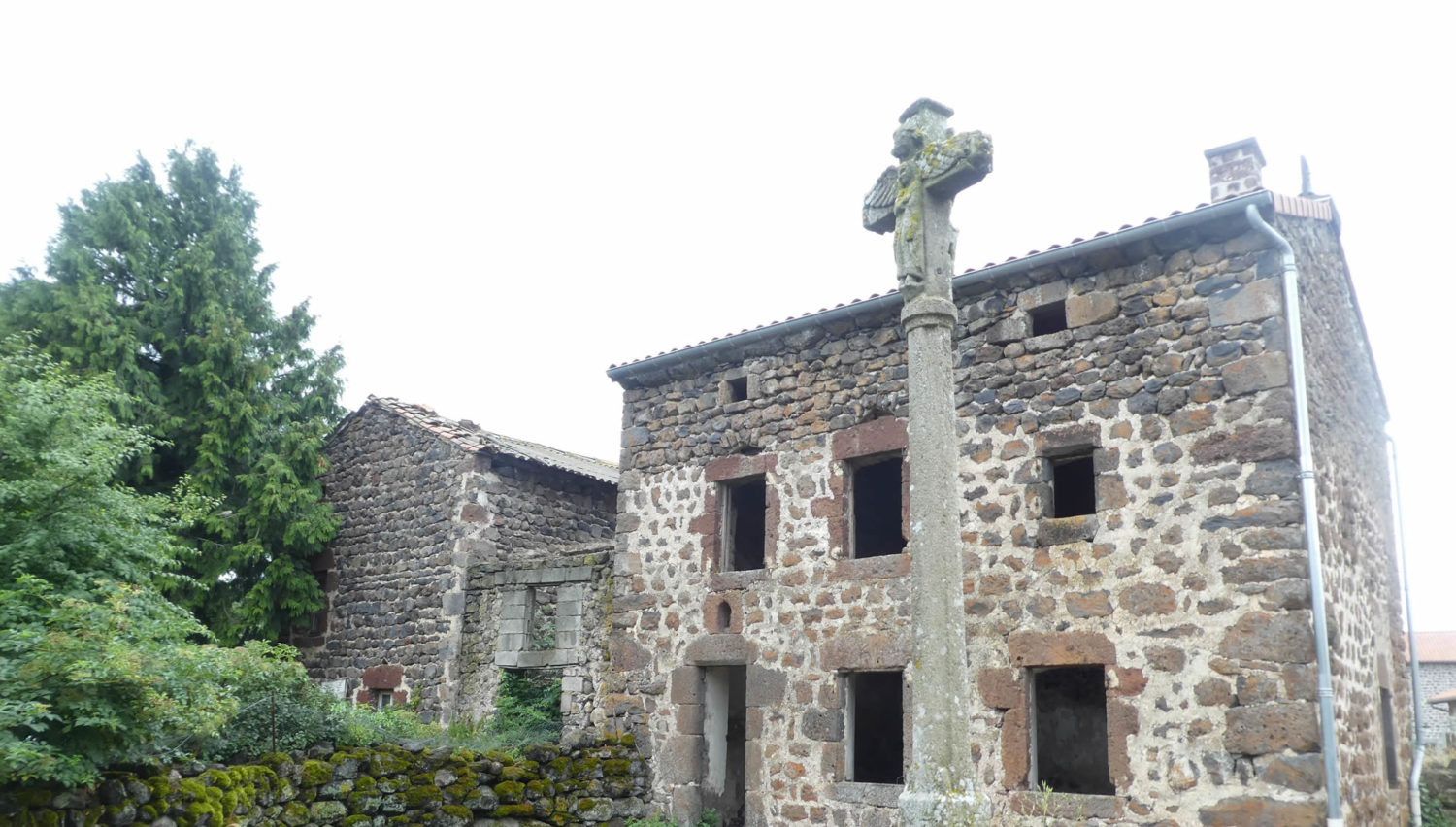Pay attention to the beast of Gevaudan
DIDIER HEUMANN, MILENA DALLA PIAZZA, ANDREAS PAPASAVVAS
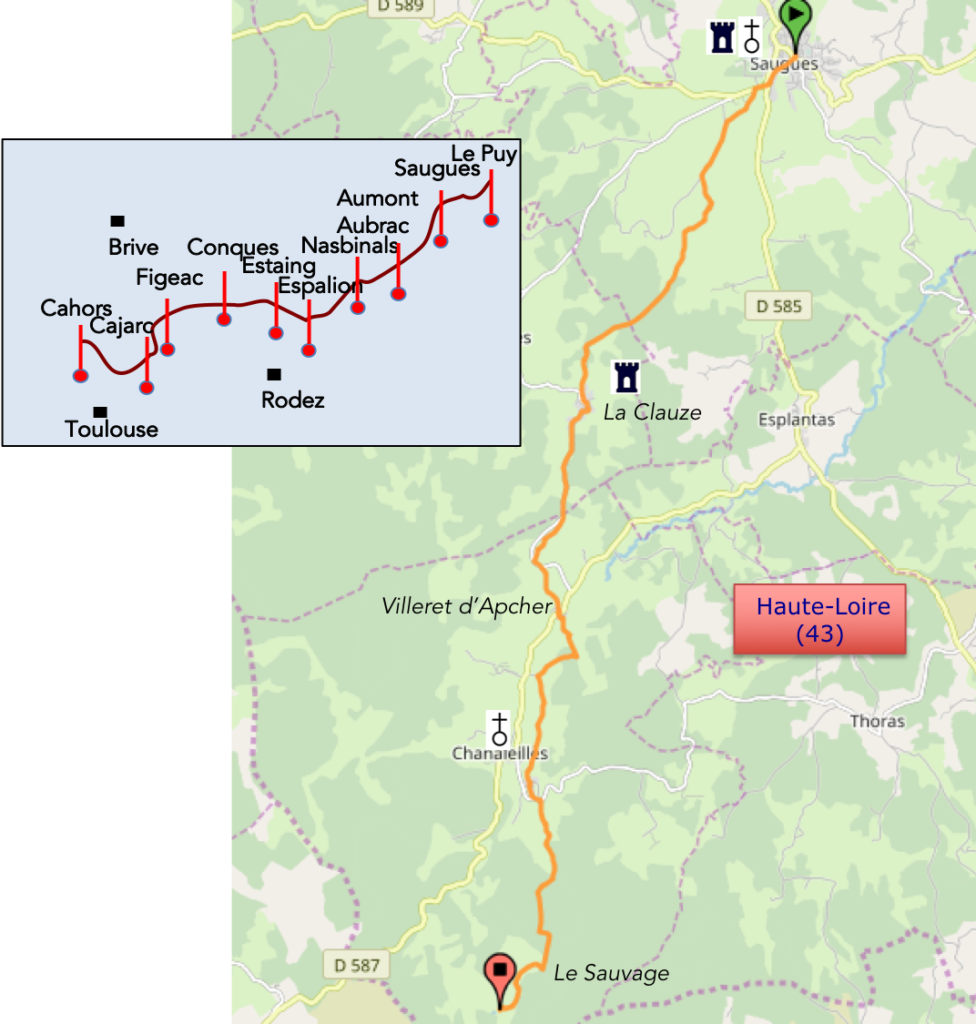
We divided the course into several sections to make it easier to see. For each section, the maps show the course, the slopes found on the course, and the state of the roads. The courses were drawn on the “Wikilocs” platform. Today, it is no longer necessary to walk around with detailed maps in your pocket or bag. If you have a mobile phone or tablet, you can easily follow routes live.
For this stage, here is the link:
https://fr.wikiloc.com/itineraires-randonnee/de-sauges-au-sauvage-par-le-gr65-29726048
It is obviously not the case for all pilgrims to be comfortable with reading GPS and routes on a laptop, and there are still many places in France without an Internet connection. Therefore, you can find a book on Amazon that deals with this course. Click on the book title to open Amazon.
If you only want to consult lodging of the stage, go directly to the bottom of the page.
Today you’ll be crossing a large part of Gevaudan, a world apart where the forest meets granite rocks, where the landscape opens and sometimes closes near remote hamlets, in the midst of forests and pastures ranged behind stone walls and barbed wire, the trademark of Margeride and Aubrac. The GR65 heads almost full South behind the Allier basin. The stage is a transition route towards Aubrac plateau. The region you are passing through is easily distinguishable from Haut-Allier and Devès areas that you have just crossed. Here the relief originates from the decomposition of the granite of the Massif Central. It is a low mountain region, rounded and drained by the tributaries of Allier and Truyère Rivers. You’ll be walking in arid lands, covered with fairly dense fir trees, pines and beeches (fayards, small beeches) and brooms. The pine is the dominant species, in the middle of blueberry and broom heaths. Here transitions are soft between open spaces and forests. On the slopes, erosion has exposed veins and small blocks of granite.
|
As granite is the normative stone of the region, the constructions are derived from it. The village surroundings occupy small spaces in the most accessible areas of the valley. The plots are often separated by ash trees, stone walls or barbed wire hung on small blocks of granite. Here, the ground is poor and acidic, because of the granitic base of the region. As a result, pasture is the primary resource. Silviculture and picking of mushrooms and lichens complete the peasant’s panoply.
There is some confusion between Gevaudan, Margeride and Lozère. In fact, all this is quite synonymous, at least in terms of landscape. Formerly, there was a large province here: the Gevaudan which included Margeride, Aubrac, part of the Cevennes to the south and Cantal to the north. Modern land-surveyors have recast this vast territory to create a department, that of Lozère. Consequently, Gevaudan is just a little larger, because it also includes part of the south of the Haute-Loire, that region you are walking through today. In any case, the monster of Gevaudan knew perfectly the cartography, having used his sharp claws on this vast territory.
The stage is thus today entirely in Haute-Loire. Nature is less tortured today. In the first part of the day, the landscape is pastoral with meadows punctuated with granite piles and houses. In the second part, the landscape changes to sink into thick forests, mostly spruce and pine, before reaching the majestic site of Le Sauvage (“The Savage”) at the end of the stage.
|
 |
 |
Difficulty of the course: The stage is short, 20 km, with continuous, yet moderate sloping (+512 meters/-204 meters). It is worth remembering that the inexperienced walker must “buy” the trip and shorten the stages at the beginning of the track. By the way, if the journey is short, it is also because many pilgrims want to spend the night at Le Sauvage (“The Savage”) at any cost. However, be careful, the site can only accommodate 41 people. As a result, many walkers continue farther to Lajo or St Alban-sur-Limagnole. The day begins with an easy climb through the countryside to the Le Pinet hamlet before reaching La Clauze, a village dominated by a tower located on top of a granite block. Then ups and downs follow each other to cross Virlange brook. Beyond Chazeaux, you enter the mysterious forests of Gevaudan, a Margeride region long haunted by “the Beast of Gevaudan.”

Throughout this stage, passages on pathways dominate those on paved roads:
- Paved roads: 6.4 km
- Dirt roads: 12.8 km
Sometimes, for reasons of logistics or housing possibilities, these stages mix routes operated on different days, having passed several times on Via Podiensis. From then on, the skies, the rain, or the seasons can vary. But, generally this is not the case, and in fact this does not change the description of the course.
It is very difficult to specify with certainty the incline of the slopes, whatever the system you use.
For “real slopes”, reread the mileage manual on the home page.

Section 1: On the hillside in the Saugues countryside.

General overview of the difficulties of the route: gentle slopes on all the section.

|
Saugues is located on a hill. The GR65 leaves the center of the village down to a roundabout where slipped a wolf that is not very graceful, it will be said like this.
|
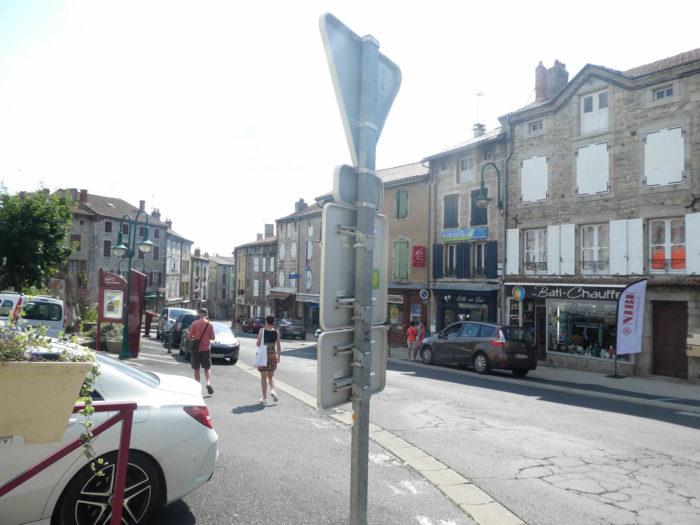 |
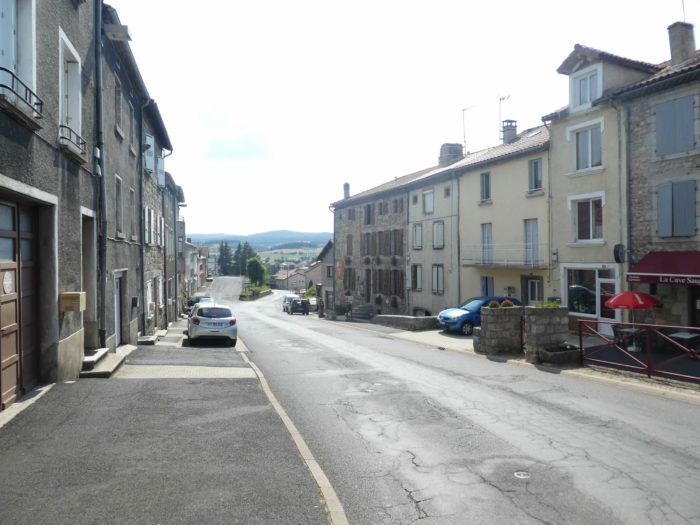 |
| At the exit of the village, the GR65 crosses the Seuge River, which is said to be overflowing in case of heavy rains, and that you will find later on the way. Today, the river behaves as an angel. |
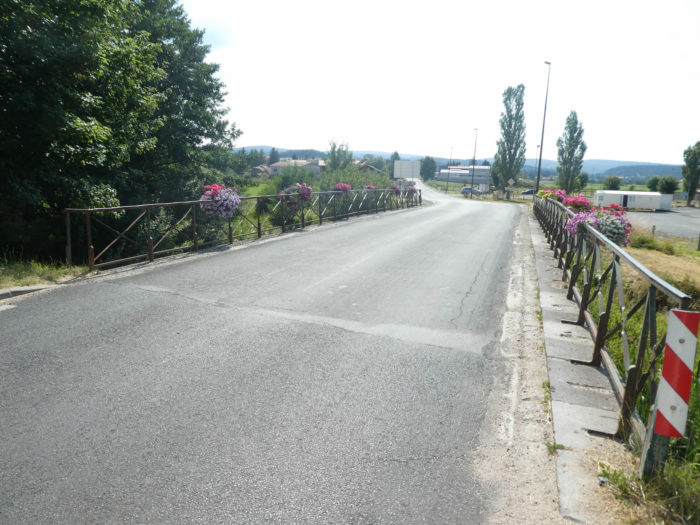 |
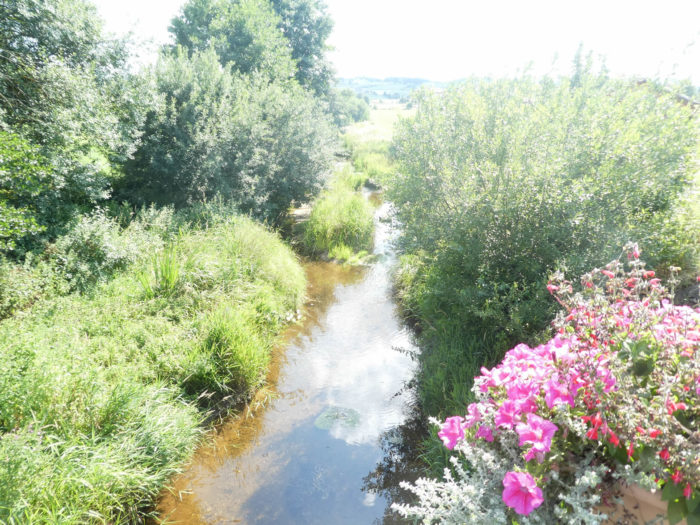 |
| Here strange wood sculptures recall the mysteries hidden in Gevaudan. Yet, this statue is not scary, it is only a lady washing her clothes near a flowerbed. |
 |
 |
But there are more harsh statues, more worrying, because this country is a country of terrible stories.
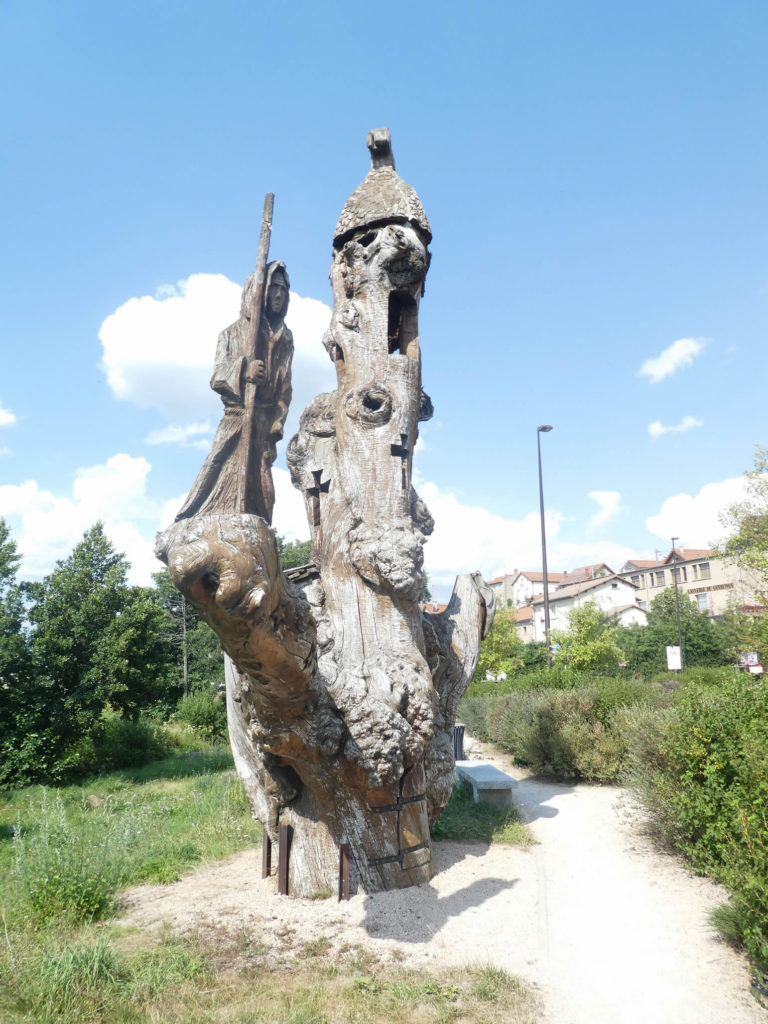
Do you love stories? Here’s one that is neither a fiction nor a legend, but established facts. A beast killed 15 women, 68 children and 6 men, injuring more. The names, the details of almost all the victims are known, from July 1764 to June 1767, living in the north of Gevaudan (Saugues, St Alban, Aumont, Malzieu, Langogne), and in Auvergne (Pinols, Ruynes).
Here is the hunting domain of the Beast. (Sanguinez: Wikimedia Creative Commons License).
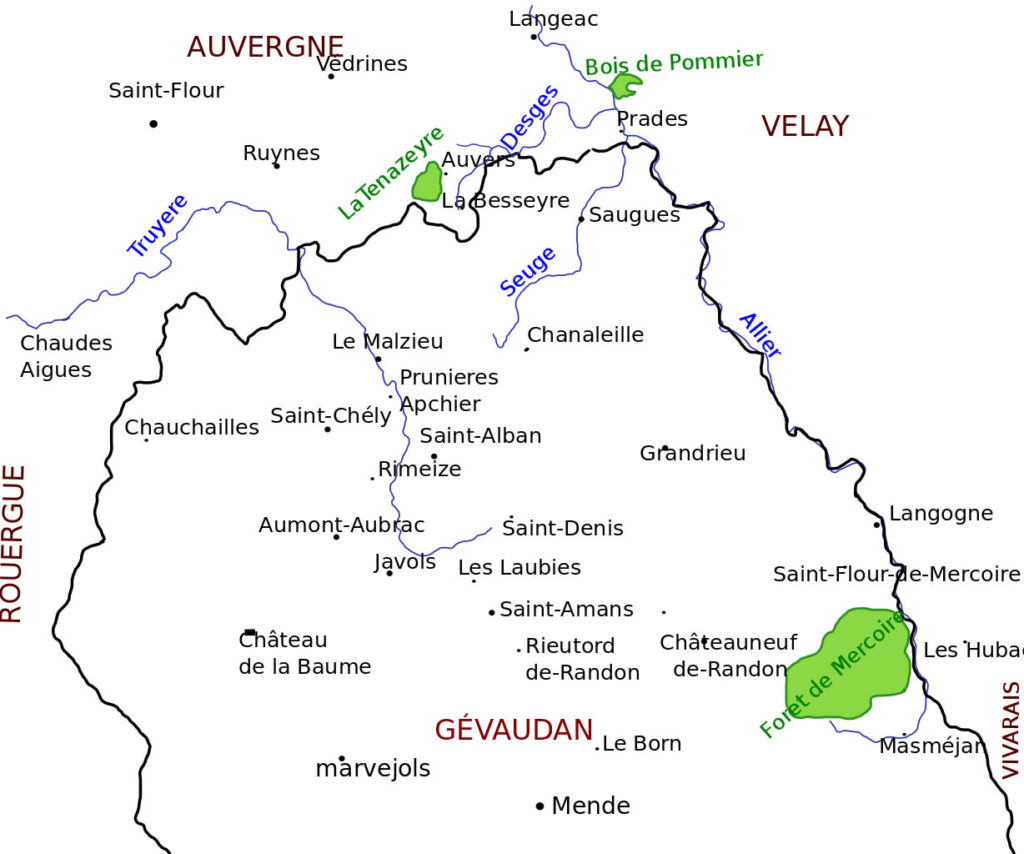
The story began in the forest of Mercoire, near Langogne, along Allier River. A young shepherd kept her cows. The beast charged. The girl’s dogs fled, but the shepherdess was saved by the horns of her cows, who chased the intruder away. She got away with some scratches. She described the monster as an animal the size of a cow, with a huge neck, small straight ears, a very long and thin tail. A large black band ran down her spine, from head to tail. At that time, experts concluded to a kind of gigantic strange wolf.

Jeanne Boulet, the first official victim was killed in July 1764 at Hubacs, near Langone. She was buried “without sacraments” because she had not had time to confess. A second victim was notified in August 1764. She was a 14-year-old girl living near Puy-Laurent. The first two victims lived in the Allier Valley. In the following months, the Beast attacked women and children, but also isolated men guarding the flocks. Many of them were devoured or torn to pieces, with scattered members in the neighbourhood.
In October 1764, two hunters repeatedly fired on the Beast. At once, the Beast collapsed, then got up again, having apparently suffered no physical damage. Captain Duhamel, who was garrisoning in Langone with his 60 Dragons, was in charge of tracking down the monster. He organized many beats in the forest without ever seeing it once. It is probably because of beats that the Beast moved in October 1764 further north, on the borders of Margeride and Aubrac areas. Shortly after, a girl was killed in the village of Apcher Prunières, near Aubrac plateau. They did not find her head until 8 days later. The Beast then attacked several times and killed many people in the Prinsuéjols area. Another time, the beast attacked a young cowherd. Fortunately for him, his cows saved him. Hunters saw the Beast roaming around the boy. They fired in vain at the animal that managed to escape. At that time, the Beast continued the carnage a little further south.

In November 1764, Duhamel and his Dragons left Langogne to settle in St Chély further north. In January 1765, the Beast attacked Jacques Portefaix and seven of his companions who guarded the cattle near Chanaleilles (small hamlet that we cross on the GR65). The children’s resistance was heroic. They even managed to reach the animal’s eyes. Their resistance attracted the attention of Louis XV, who allocated a rent of 300 livres to Portefaix and another of 250 livres to the rest of the group. The king began to take this matter seriously and sent professional wolf hunters to the area. With 8 dogs, Denneval, father and son, arrived in February 1765. For months, they killed many wolves, but the attacks continued. In June 1765, François Antoine, the king’s arquebusier and Hunt’s lieutenant replaced the Denneval. They landed at Le Malzieu.
In September 1767, François Antoine was warned that a huge wolf lurked in the woods of Chazes Abbey. The Beast had never appeared in this region of the Allier. With the help of 40 hunters from Langeac, François Antoine shot the animal. It was just a big wolf weighing 130 pounds. The survivors identified the animal as responsible for their misfortunes. Monsieur Baker, the Saugues surgeon, dissected the animal and stuffed it. The animal was sent to Versailles, where it was exhibited in the gardens of the king. François Antoine became a national hero. Officially “the Beast of Gevaudan”, now known as “The Wolf of Chazes” had been killed.
But there! In December 1769, another Beast appeared in the area, wounding two men. Then followed many deaths. It was Jean Chastel who shot the animal in June 1770. Many controversies exist about this new case. Baker, surgeon at Saugues, dissected the animal and stuffed it. The animal was exposed for some time at the Castle of Besque, then sent to Versailles. Arrived in Paris, the animal was in advanced state of putrefaction. The king refused to see the animal. Moreover, officially, the Beast of Gevaudan was the wolf of Chazes (there is a lot of politics under all this business!). The great Buffon, who inspected the animal, concluded that there was a big wolf. There remains no trace of Buffon’s writings. The animal was buried in the garden without any trace. According to tradition, the animal killed by Chastel is the true Beast of Gevaudan, because from this date, the carnage stopped immediately.
Many mysteries remain about that story. The distances covered by the animal were significant, more than 50 km a day. This led to the hypothesis that there may have been more than one killer animal, even though it has never been proven. The animal was described as a wolf, but it was not a real wolf, with its striped back, its hairy tail, its gigantic jaws. The animal was devouring its victims, crushing their heads, feasting on the bowels. Baboon, leopard, bear, wolverine, striped hyena have all been proposed as an explanation. Others see it as a werewolf, a phantasmagorical animal. What is known for sure is that the animal revelled in human flesh, ignoring sheep and goats. The animal was resistant to bullets. Either, but at the time the armament was hardly modern! This mysterious story still fascinates people today, two centuries after these extraordinary events. So, open the eye and the good one in the forests when you’ll walk around the Sauvage. Fortunately, the good Saint watches over you.

| Quickly, after a passage on the departmental road, the GR65 gently climbs towards Pinet hamlet, in the countryside. |
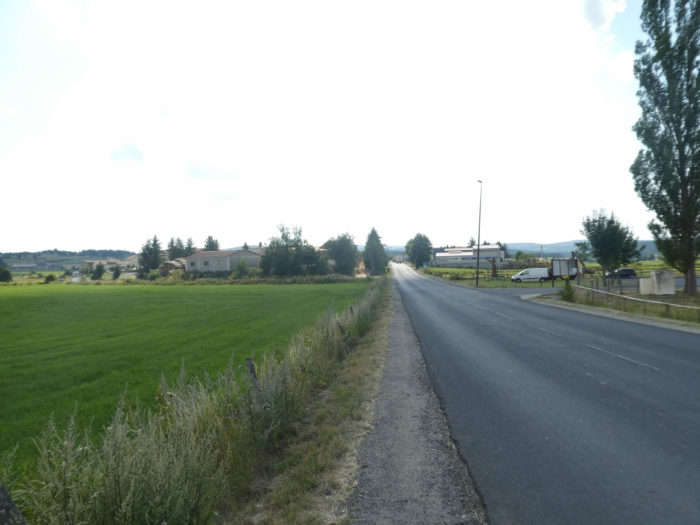 |
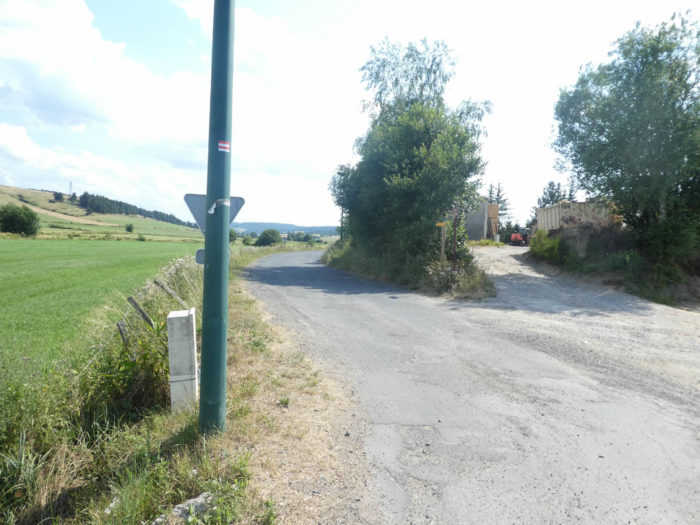 |
| It follows for a moment the paved road that runs to the recent settlements by the river, then finds a wide dirt road. |
 |
 |
| Here is the real life of a farmer. Without blush, the region exhibits the everyday life of ordinary rural life. The peasants must be as severe and reserved as the granite of their houses. |
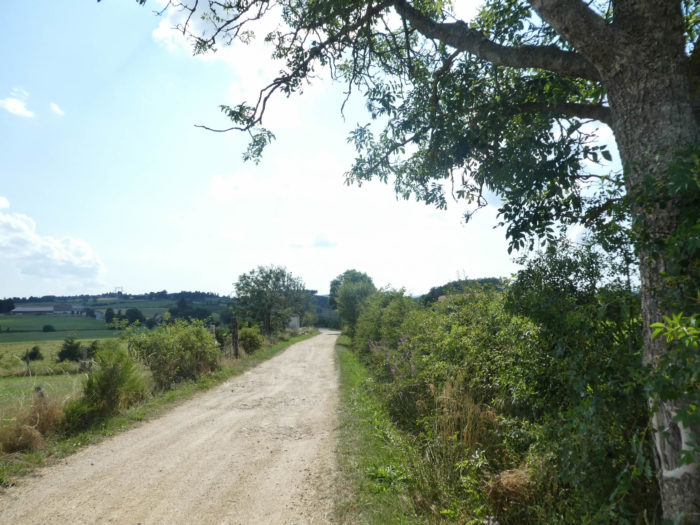 |
 |
Fortunately, the cattle distils its charm on this immense open space. The region of Saugues has made a name over the years in the world of breeding. The Saugues market is the brand. Herds of sheep abound in the meadows.
The Blanche du Massif Central is the most widespread. The sheep wears a thin, white head, and is devoid of horns. The long ears are a bit pendulous. The fleece is white leaving exposed the head, the top of the neck and part of the belly. Rarer are the Bizet sheep, recognizable by their black head with a white band on the muzzle.
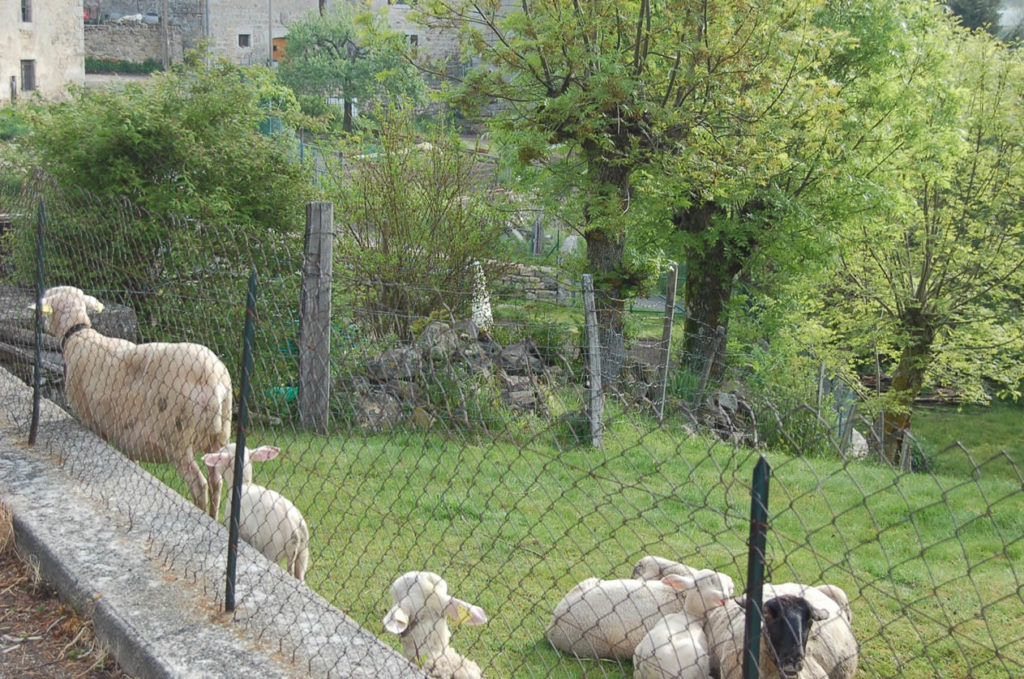
| Here it is especially the dairy cow that you’ll meet, most often Montbéliarde or Abundance. The Monbéliarde cow, you have already met. Abundance is the dairy cow of Savoie and Haute-Savoie, the Reblochon cow. But the cows are also present here, in their mahogany dresses, their heads rather white with their red glasses around the eyes.
But there are also pure breeds, such as Aubrac, Limousine, Charolais or Salers. These breeds are not good dairy cows. They are raised mainly for butcher’s meat. |
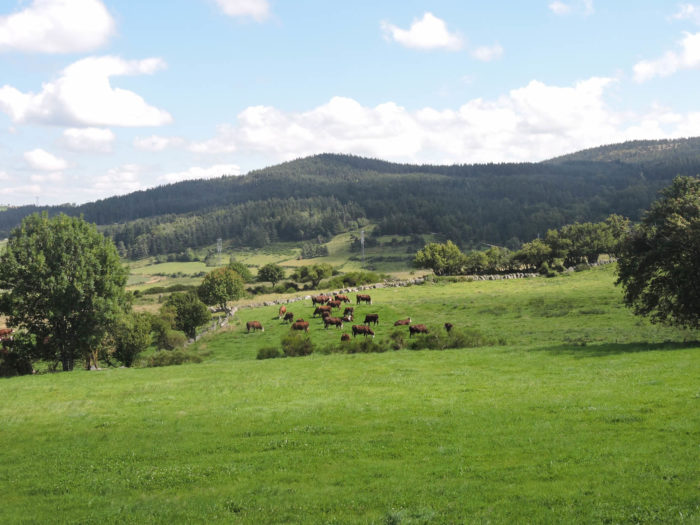 |
 |
| The paved road starts climbing in the open countryside, but the slope is not demanding. There are many ash trees in these meadows. This is easily explained. Formerly, ash fruit was used as a dietary supplement for livestock. So, the farmers planted a lot of such trees, even if today they are primarily decorative. Anyway, what beautiful ornamental trees, no? |
 |
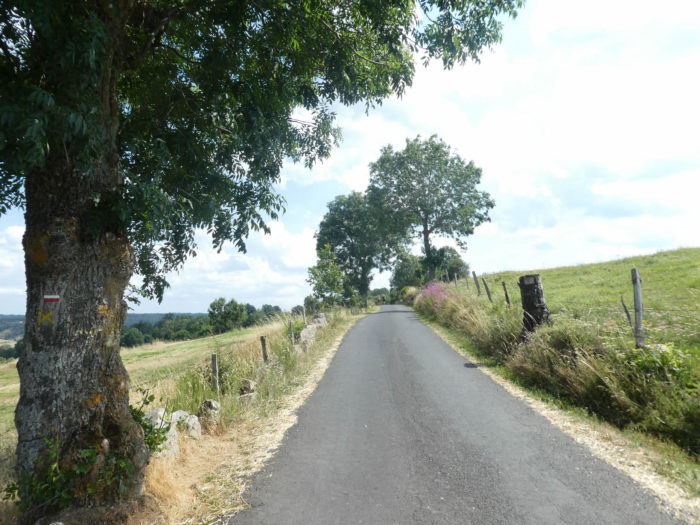 |
| Further up, a bifurcation, with an iron cross planted in the granite. The crosses stand like lanterns in the storms, indicating the entrance of the ports, as so many milestones on the way, protecting the traveler. The road takes the direction of Pinet hamlet, in a gentle, calm countryside, with Aubrac and Charolaise cows that frolic above. |
 |
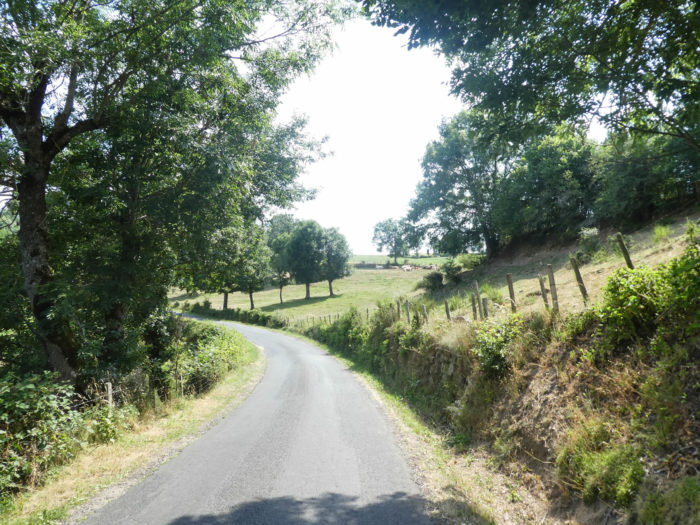 |
| Shortly after, the road gets near the first farms of Pinet. You left behind the volcanic stones of the Dévès for the granite of Margeride. Yet, it is just as marked with majesty and robustness. |
 |
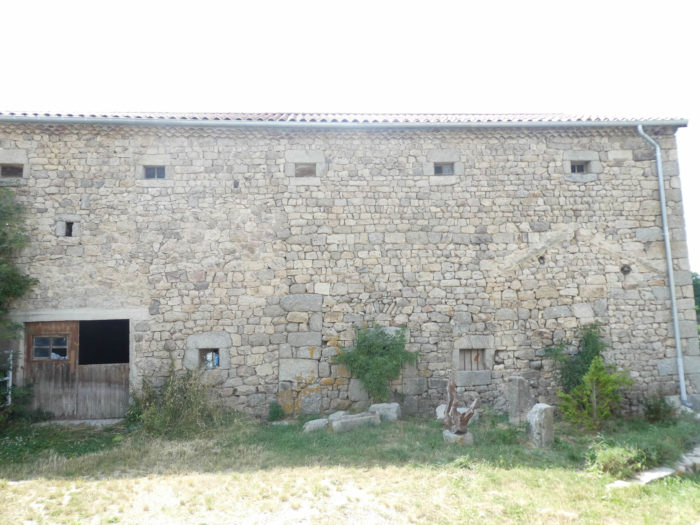 |
| Another cross, a beautiful alley of ash trees, and an iron device to shoe the oxen, and the road passes in the heart of the hamlet, a handful of large farms, that the chisel cutters trenched in the flanks of the purest granites. In this compact, hard and everlasting stone, the farmhouses flower good cattle and good soil. |
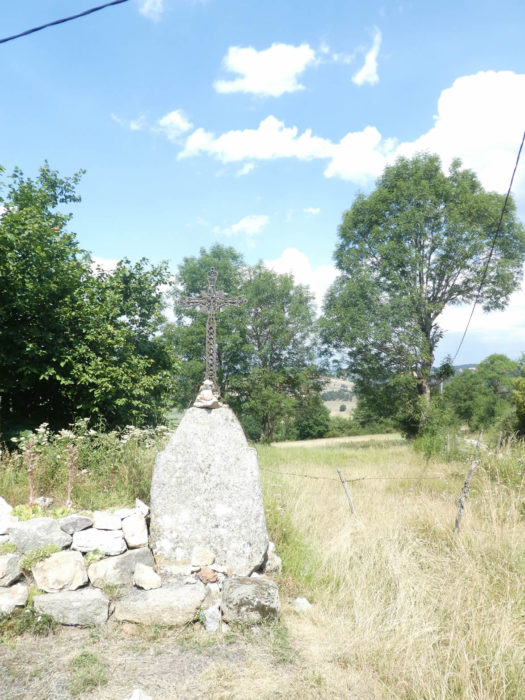 |
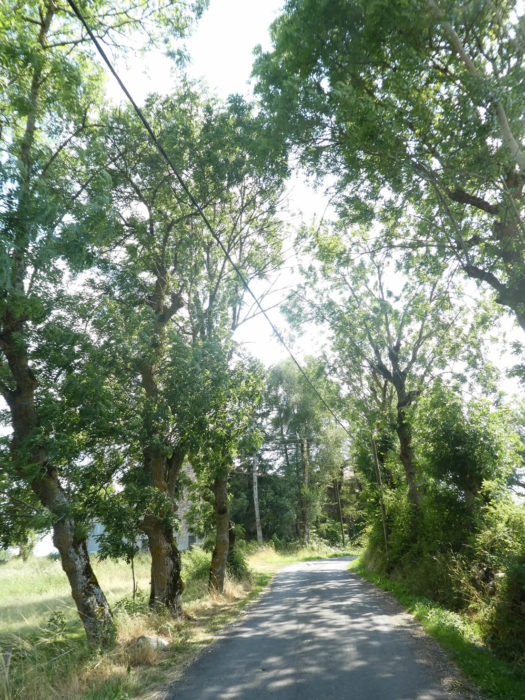 |
| Beyond Le Pinet, a wide dirt road will meander for a long time in the meadows, with here and there a few bunches of ash trees and solitary maples. The brooms and the brambles furnish the banks. |
 |
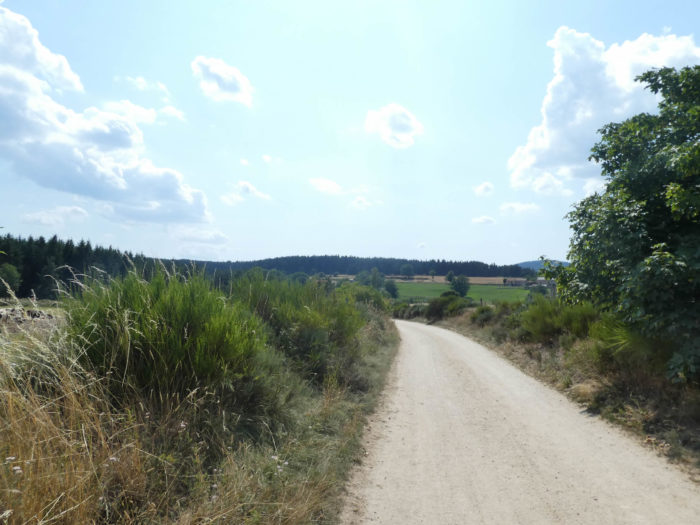 |
| Sometimes the cattle ogle the pilgrims who pass, sometimes looking away. By dint of seeing pilgrims every day! Here two pilgrims are surprised that one can spend time photographing cows, not pilgrims. Hopefully, they may see themselves here by accidentally opening this site? Thanks to them for their nice smiles. |
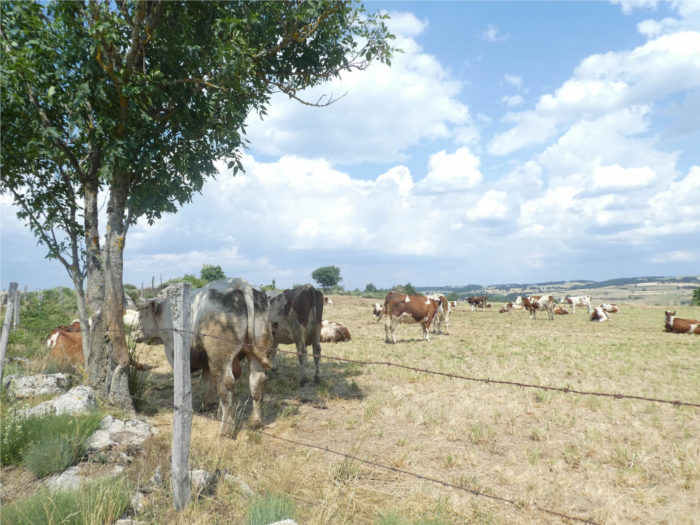 |
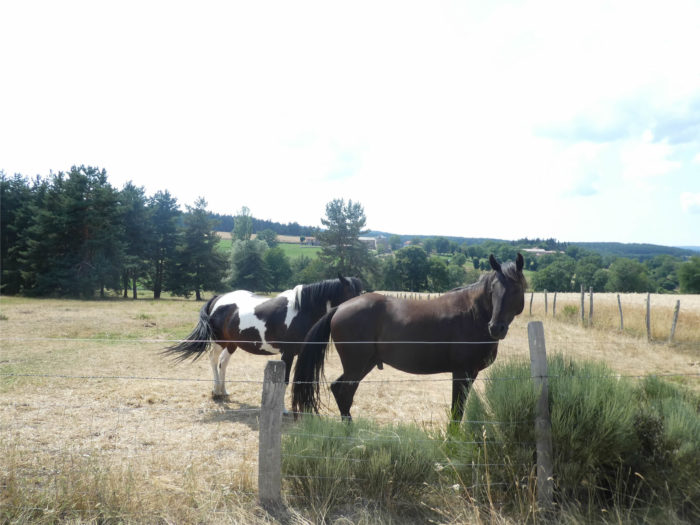 |
| The dirt road walks for a long time, between meadows and pine forests, without really ever entering. |
 |
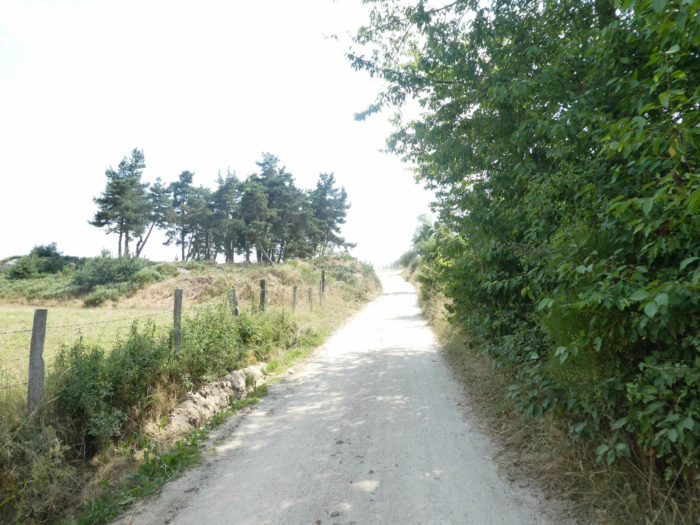 |
Section 2: Light ups and downs in the forest.
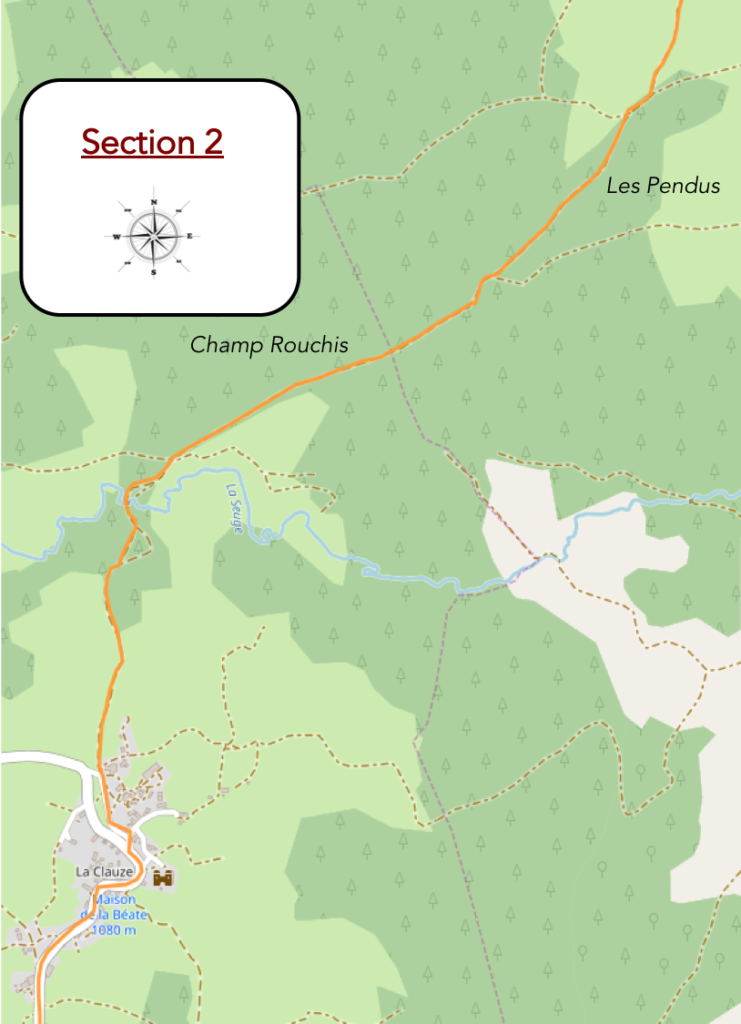
General overview of the difficulties of the route: gentle slopes, except around the Seuge brook passage.

| Further on, there are fields of rye, at the foot of spruces and pines. Rye is the wheat of Saugues. But these are never large fields, and the groves leave little room for the peasant. The tall pines take the place of the shrubs and the soil is tinged with brown. |
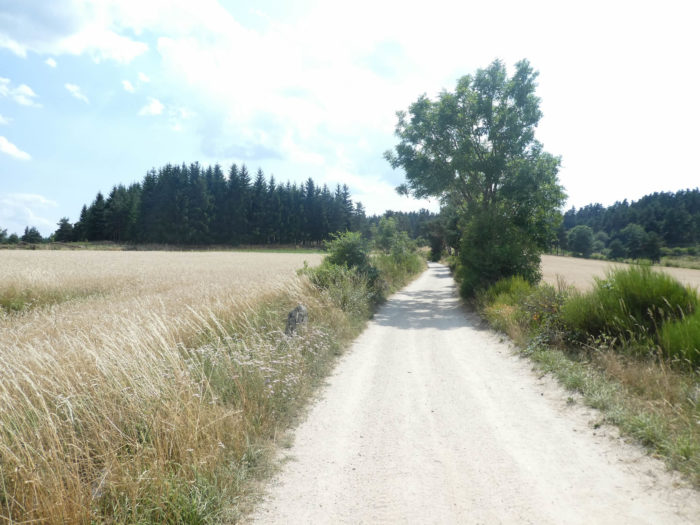 |
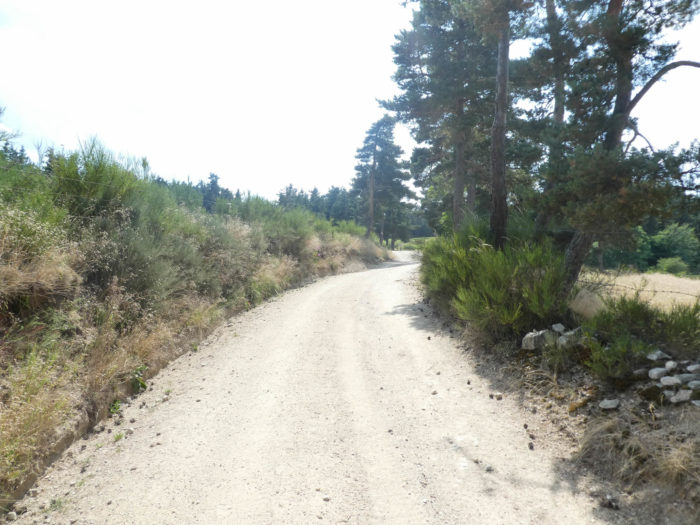 |
| Further ahead, the land gradually gives way to the forest. Here it is most often conifers, Scots pines in particular, along small dry-stone walls or barbed wire, behind which graze herds of cattle and sheep. Peace reigns there. The grass grows thickly and the trees circle around the clearings, where wild grasses grow here and there, sometimes giving it an air of clutter. |
 |
 |
| The hill is steeped in soft curves, in rounded valleys, its sides offered to the sun or to the drizzle, it is according to. In these green cathedrals, even the Aubrac cows, usually so warm, remain sometimes indifferent to the pilgrim who walks. Sometimes a light breeze gives the forest the deep breathing of the sleeper. |
 |
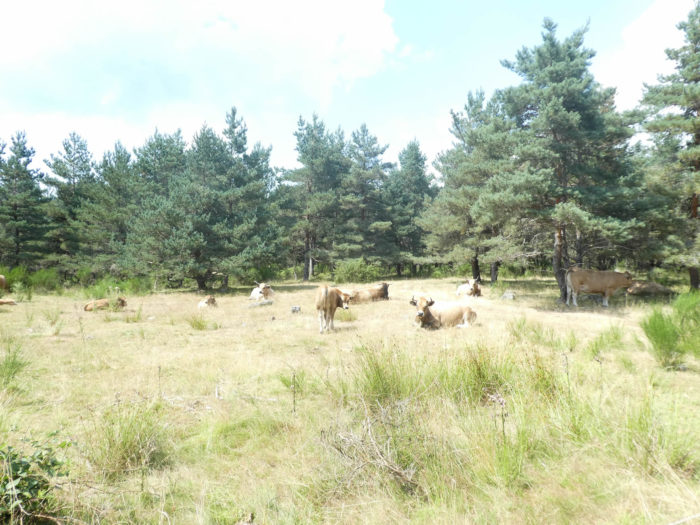 |
| The wide dirt road ripples gently from the pine forest to the clearings, to return further into the woods. The pines are all erect, slender and slender, rising towards the light. |
 |
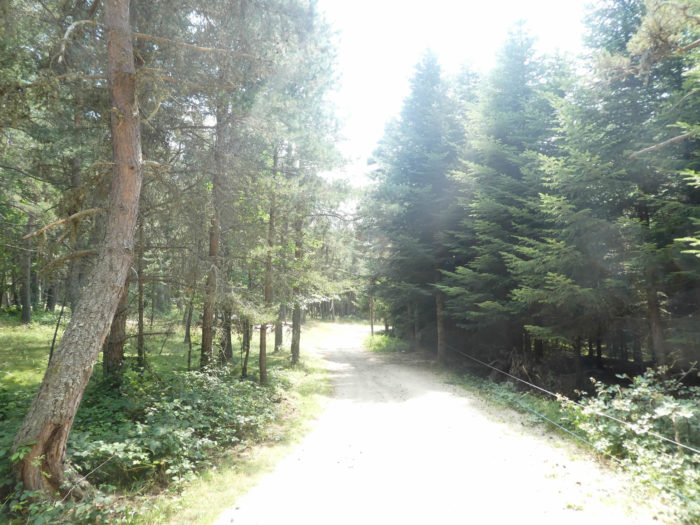 |
| After climbing without noticing anything particular more than one kilometer, the GR65 slowly slopes down towards the Seuge River. Pine cones litter the ground. In places, blueberries line the ground. The track is constantly running among the mystery hidden here for centuries, that of wolves, witches and gods. |
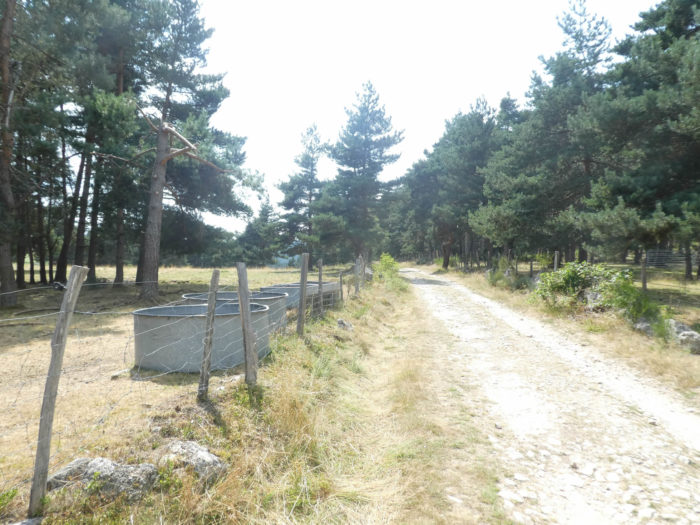 |
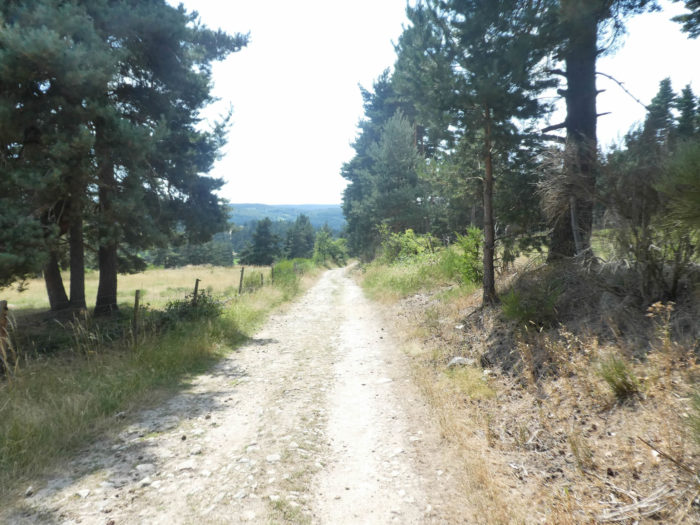 |
| Further ahead, the pathway is gradually coming out of the pines. Ash and maple trees are coming back. |
 |
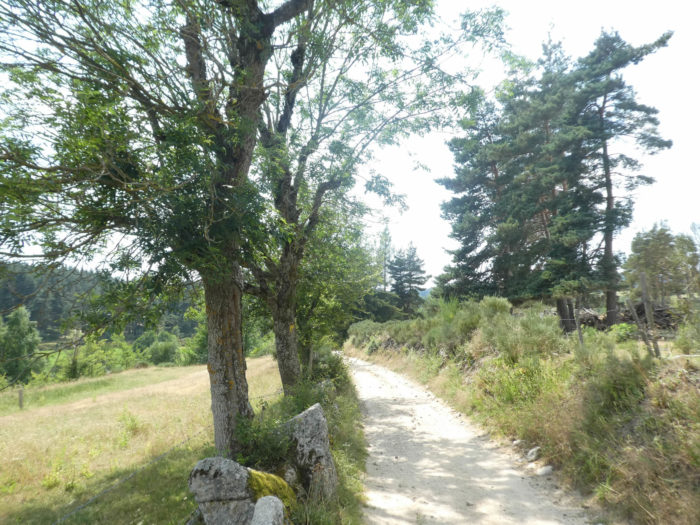 |
| It gets to a place known as Le Champ du Cros. Here a direction for a gîte, 1.5 km from the track, is given. In the country, they are only small hamlets, as quiet as the woods around. |
 |
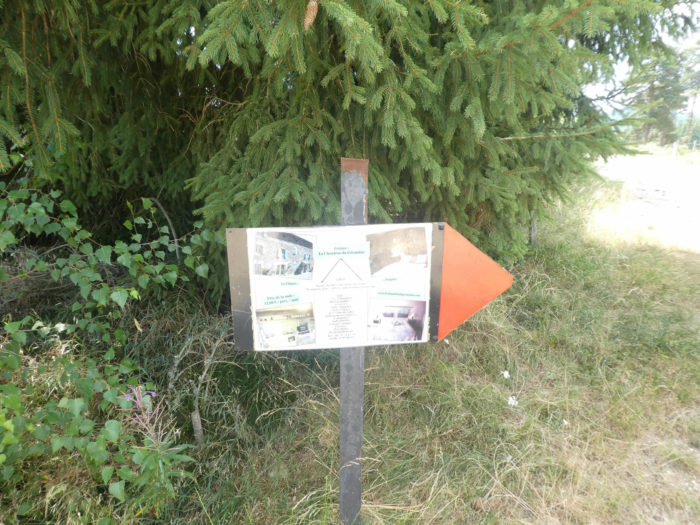 |
| Along the way, still a beautiful granite house. In these countries where not much happens, you never know if these beautiful homes are still inhabited or if they are only second homes. |
 |
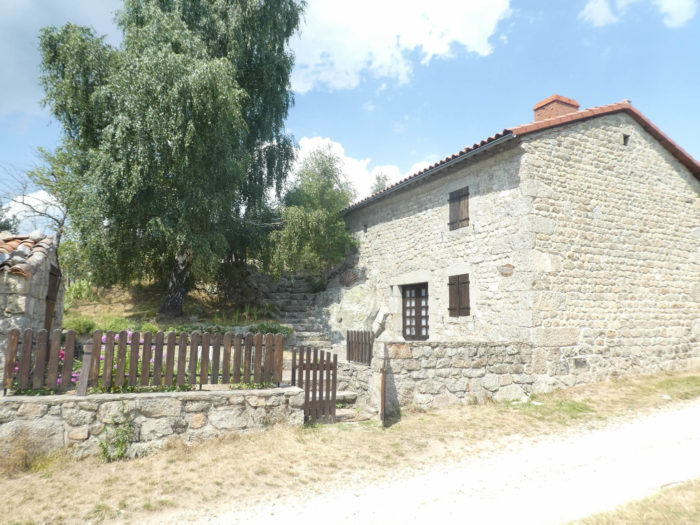 |
| Further down, The GR65 finds again the Seuge River and crosses it. You have to bend down to see a stream of water flowing. |
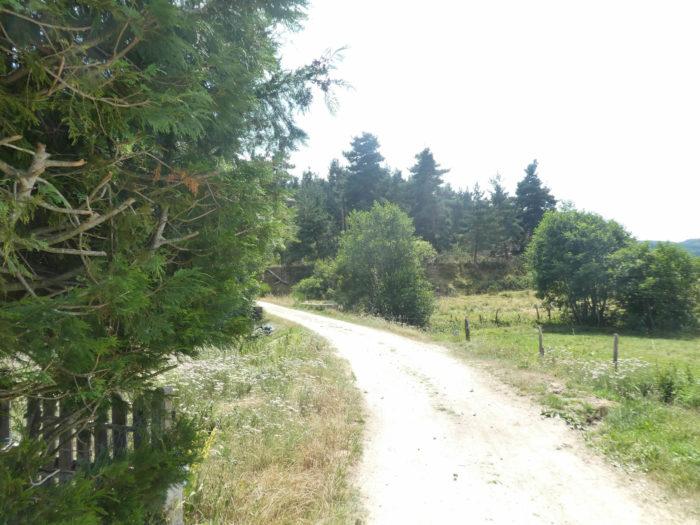 |
 |
| Beyond the stream, the pathway climbs a little more on the dirt in a large clearing, then in the countryside towards La Clauze village. Sometimes some barbed wire on stone walls punctuate the meadows under the ash trees. |
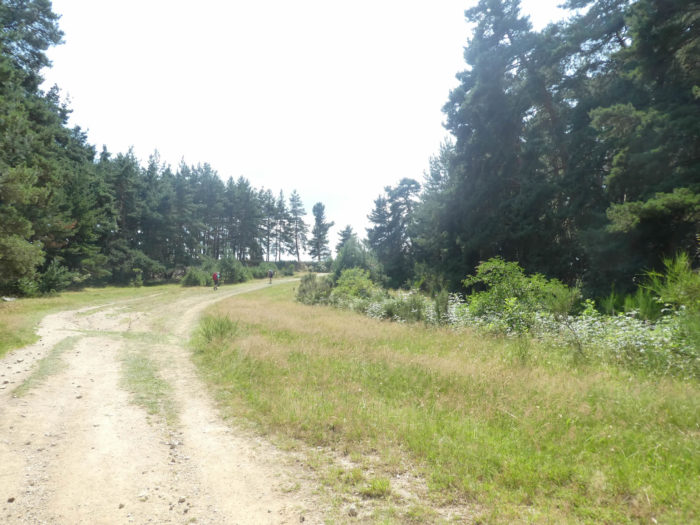 |
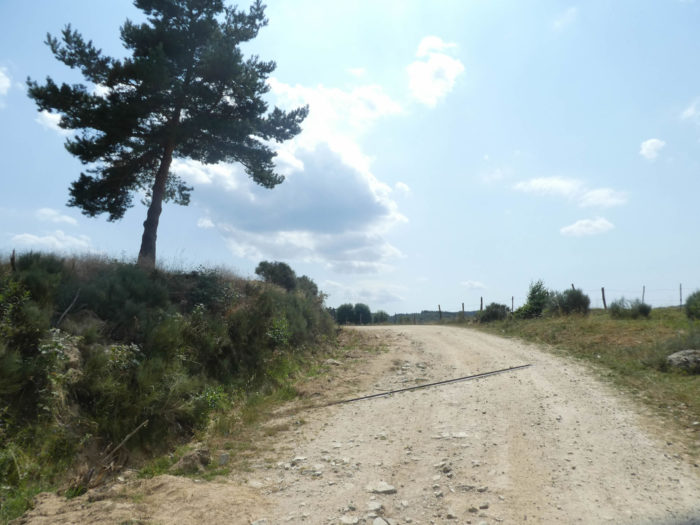 |
| At the approach of the hamlet, the tar regains its rights. It is always so. Tractors, unlike pilgrims, do not like to get bogged down in the mud. |
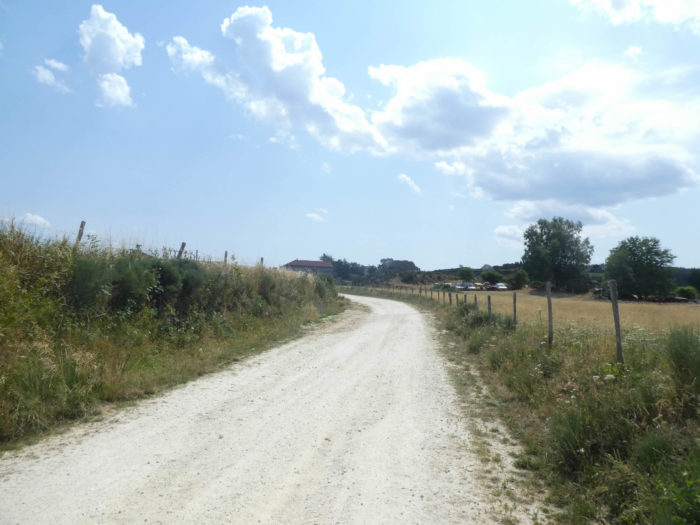 |
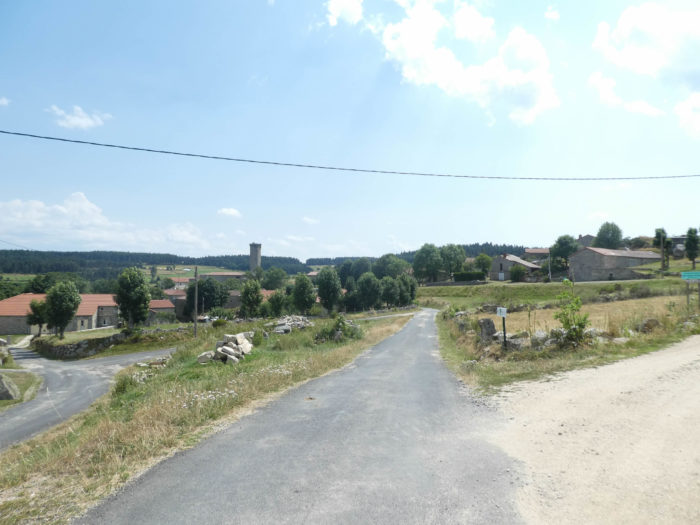 |
| The granite hill of the Clauze carries a proud, an heptagonale tour stands on the granite hill, reflecting the affirmation of a seigneurial power who ruled at the time. A ladder was needed to access the machicolations and the high loopholes. Castles, fortresses, dungeons, nothing is missing in the old Auvergne, that of small local potentates with a rather warlike spirit. All these prestigious marks of a bygone past, these castles, deemed impregnable, remain erect on their mounds, in ruins, witnesses of a vanity forever buried. |
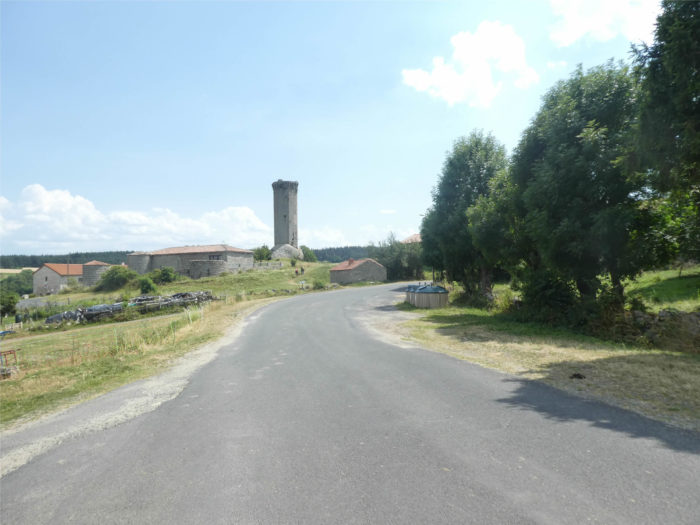 |
 |
| In La Clauze, granite is everywhere: in its 12th century tower, in the refuge of the Maison Béate, in the houses of the village, in the fountain as well as on the sumptuous device to shoe oxen. |
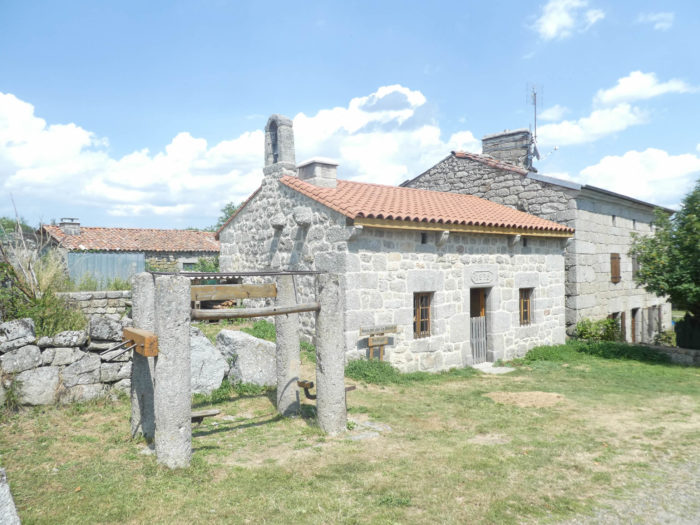 |
 |
| The Béates belonged to a secular institution of the 17th century. They were catechumens, playing the role of nurses, housekeepers, assisting the dying, paying attention to the weak, ensuring the good care of the village communities. It’s just a memory, a stone house among the others. But now, these shelters are still used today for pilgrims, often young and quite penniless. It makes them a free night. There is even a kitchenette, luxury, right? |
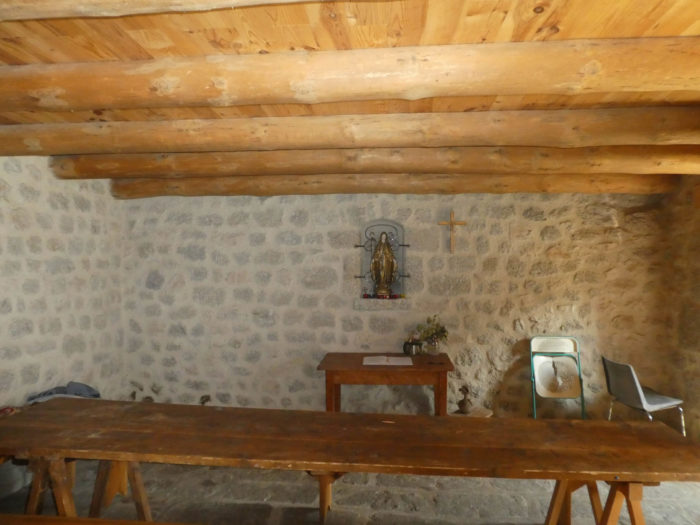 |
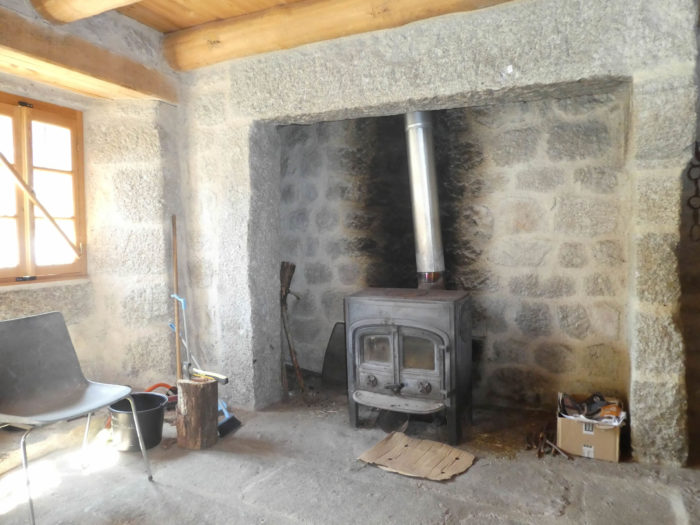 |
| In the village, the buildings are quite imposing, built to withstand storms, with their walls of light granite. Alas, the villages are like castles. “Deep France”, rural France is dying. Many houses are in ruins or uninhabited in the village. Stone is omnipresent in the country’s buildings. The main model of these hamlets is an aligned farm which includes the house, the cow-shed and the barn. The barn is often above the cow-shed, and it is reached by an arranged climb, under which is stands the pig’s sty.
In Gevaudan, a large part of the territory was formerly formed of communal property that the peasants shared. This organization has disappeared today, but there is sometimes an embryo of “couderc”, a free space in the middle of the village, accessible to all, where you’ll find the common house, the bread ovens, the laundry and the famous craft to shoe oxen, some of which are still functional today. |
 |
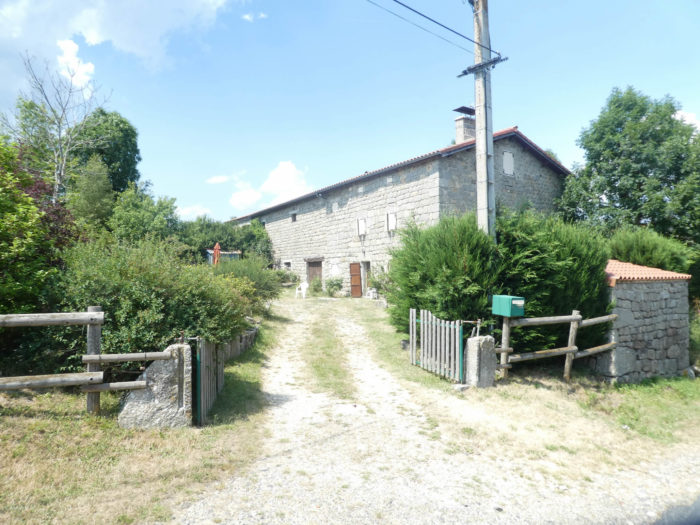 |
| At the exit of the village, the GR65 flattens on the paved road. Here and there you can see crumbling walls, still barely supported by old beams blackened by the weather. The moss colonizes what remains of past lives here. France’s poor peasants die first. Here you have for a long time to walk along the paved road, with as horizon the dark forests standing in front of you. |
 |
 |
Section 3: In the footsteps of the monster of Gevaudan.
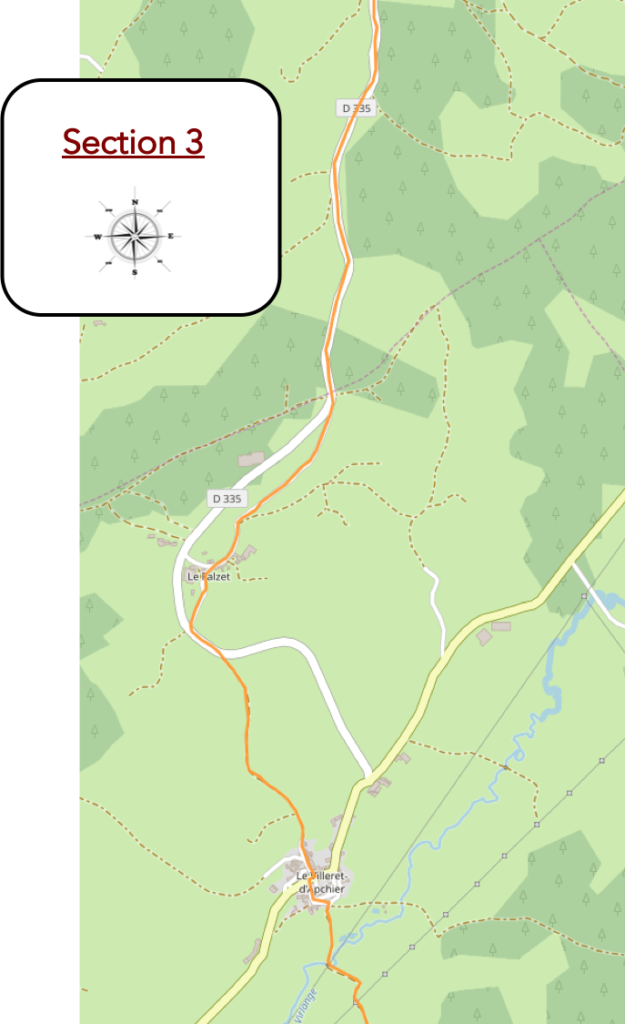
General overview of the difficulties of the route: light sloping in general, except some more pronounced, but short slopes, near Villeret d’Apchier.
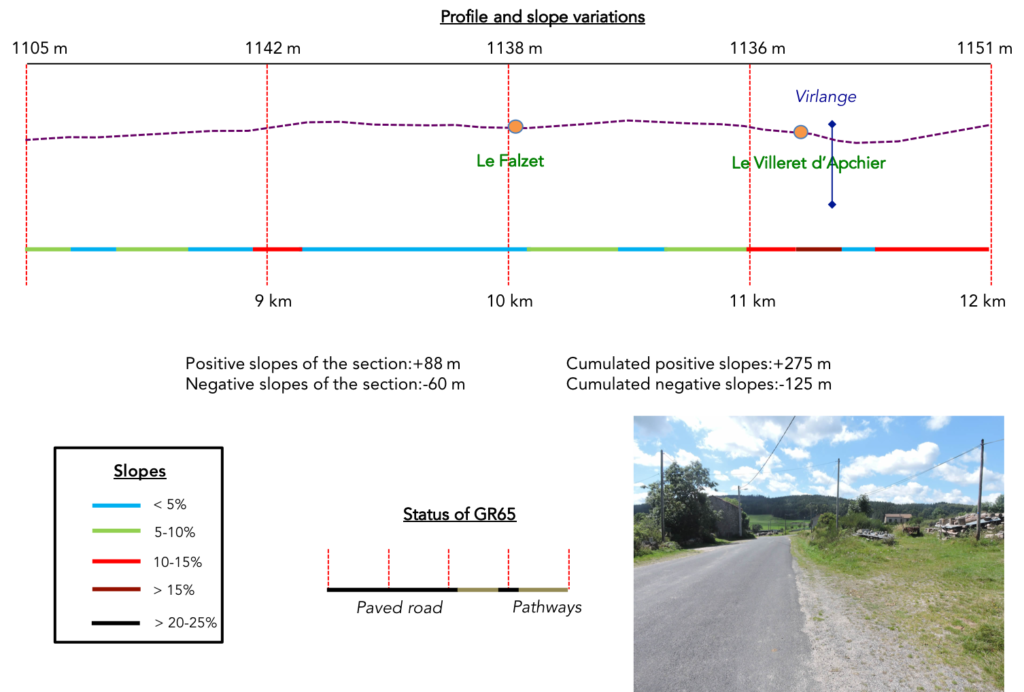
| Here this is not the most exciting route of the stage, as he GR65 follows the paved route, but the pilgrim is not really bothered by the traffic. You‘ll be walking in open country, but the countryside is beautiful, far from civilization, sometimes with very small isolated farms, a field of rye here and there, a few quiet herds in the fields. |
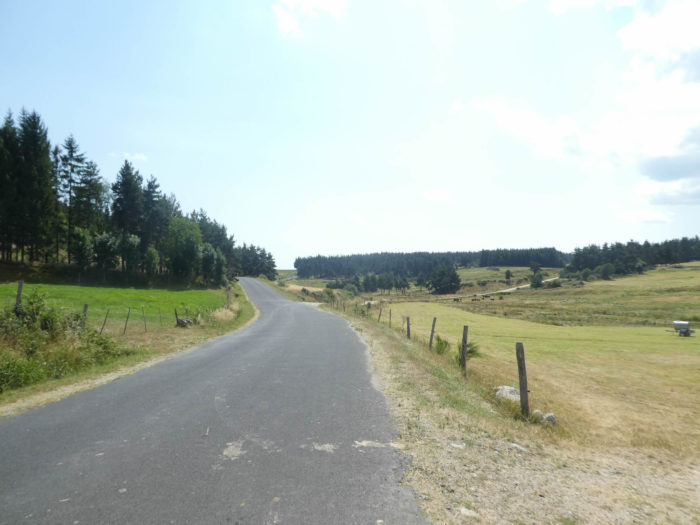 |
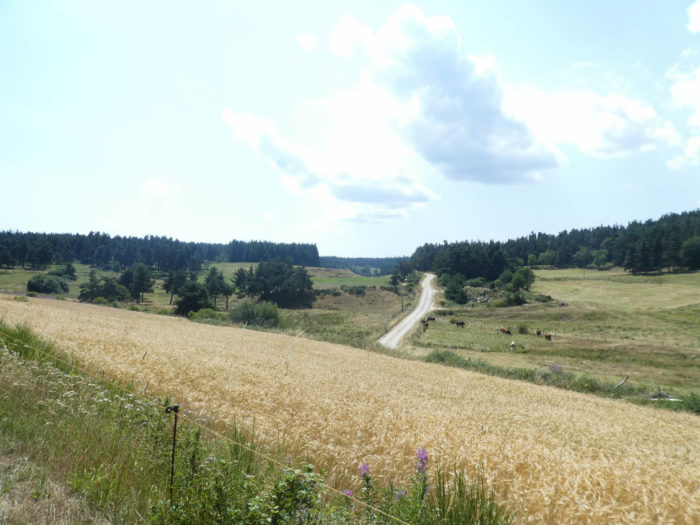 |
| The route ripples on the tar, in the pastures of the wooded hill, then steeply slopes up a few hundred meters. It is in these places of great solitude that the pilgrims, stuck in their thoughts, sometimes raise their eyes to see their progress on the road. |
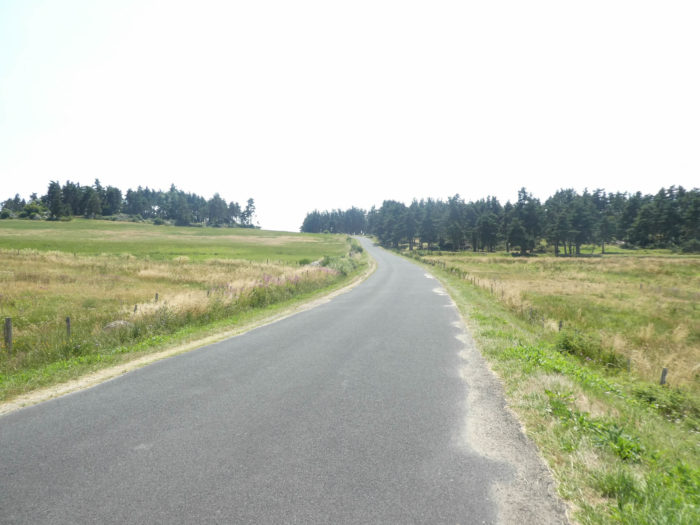 |
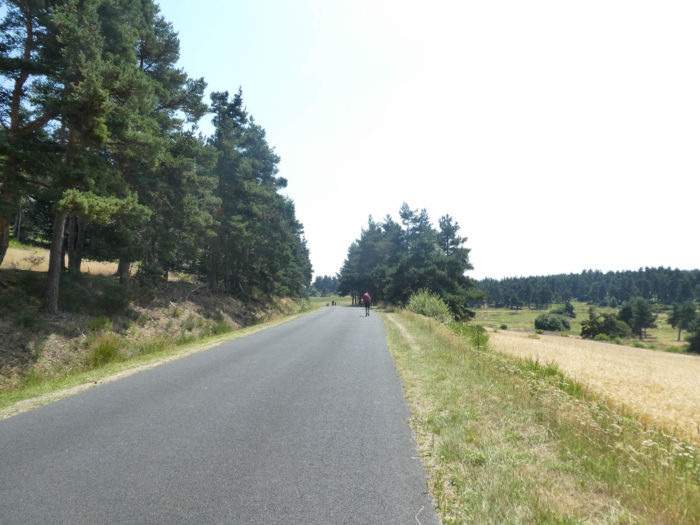 |
| At the hilltop, the GR65 leaves the road where rarely a vehicle transits, for another small road that gently slopes down to Le Falzet. |
 |
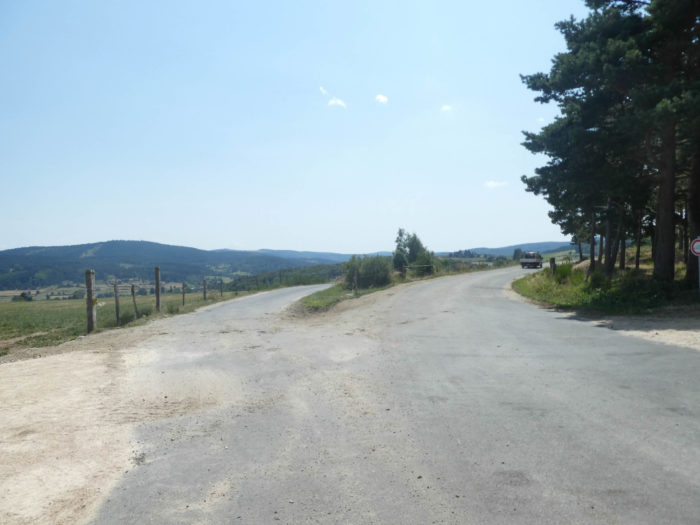 |
| The paved road then descends into the broom, under the ash trees and maples. |
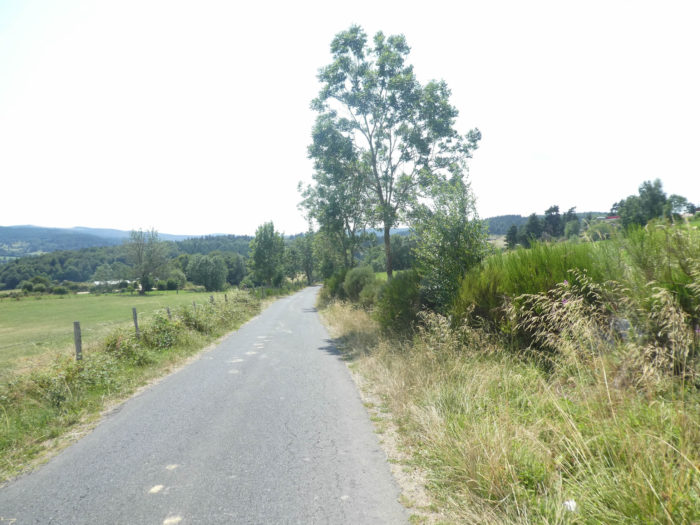 |
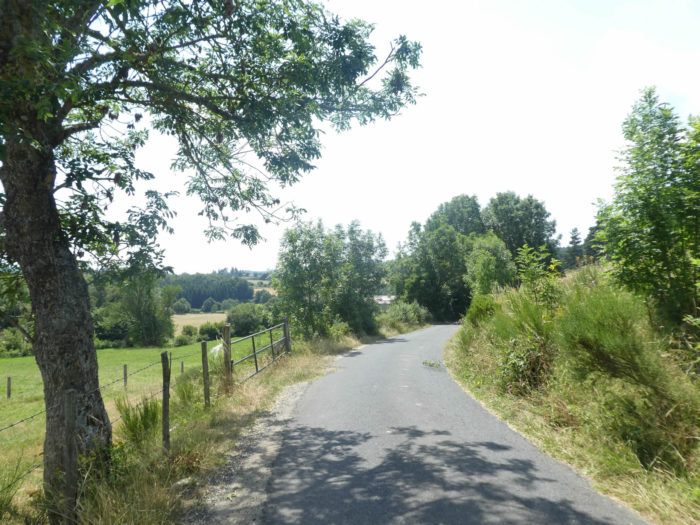 |
| The further you come down into the small dale, the denser the vegetation is, and you will also see great hornbeams and plump beeches as you approach the Falzet. |
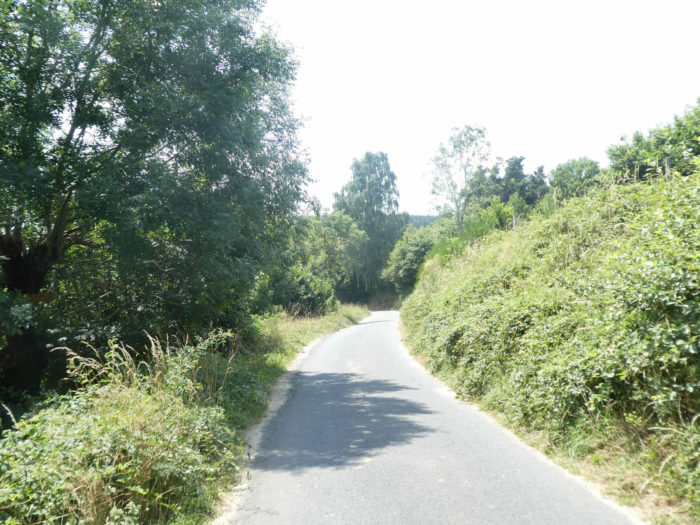 |
 |
| At Le Falzet, a farm serves as a refreshment bar, with the products of the farm. We can never say enough about the intense pleasure that comes from these havens of peace and comfort during the pilgrim’s hard day. |
 |
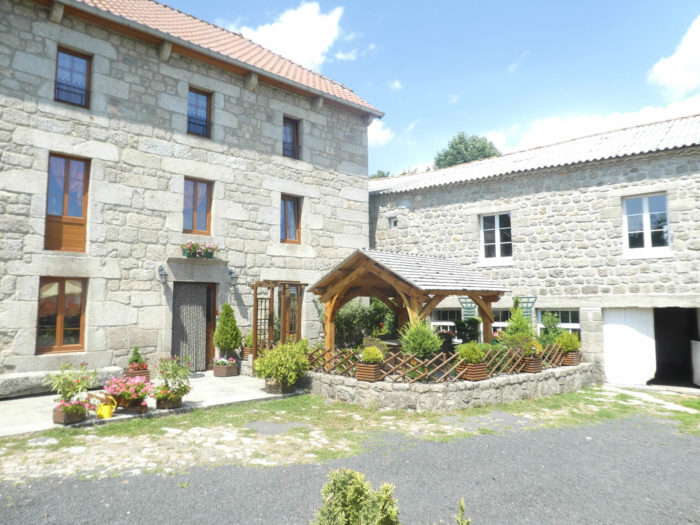 |
| In the village, everything breathes the splendor, solidity and charm of light granite. |
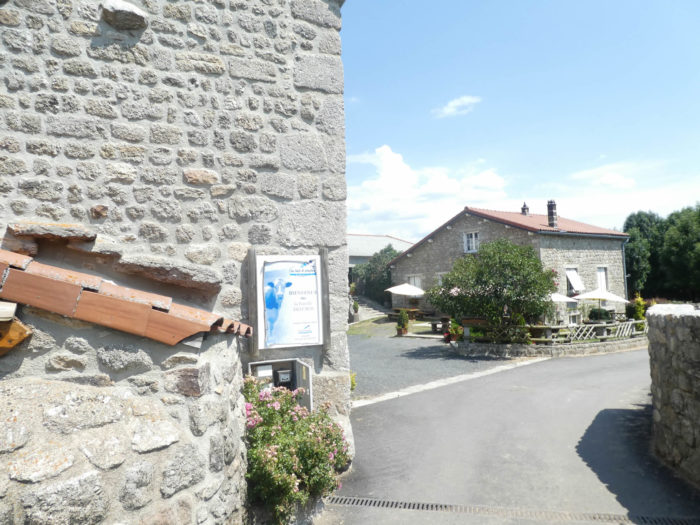 |
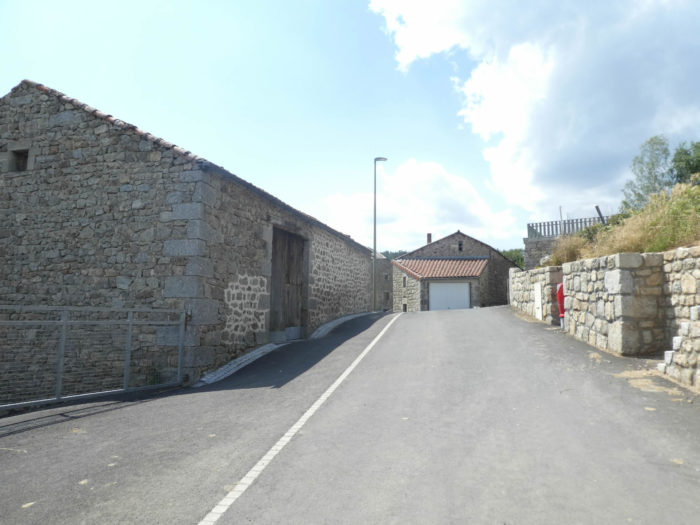 |
| Beyond the village, the GR65 still remains a few hundred meters on the paved road before taking a wide dirt road climbing to Le Villeret d’Apcher village. |
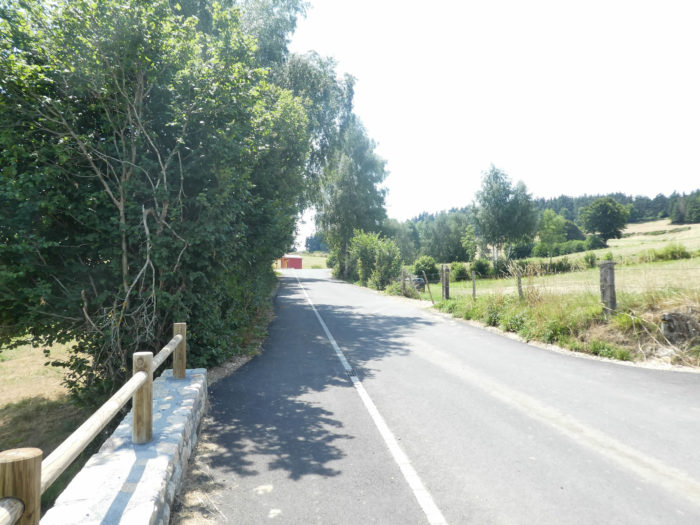 |
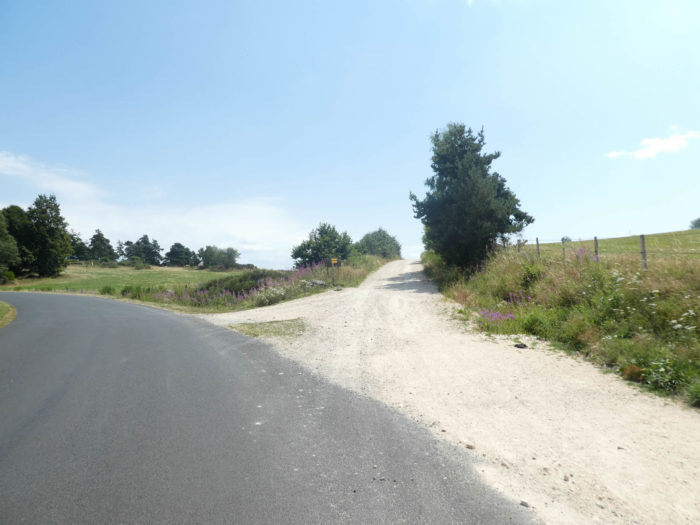 |
| This is again the intact countryside, its meadows permanently limited by barbed wire to contain cattle, punctuated here and there by ash trees, maples or solitary beeches. |
 |
 |
| Further ahead, the pathway gently slopes down towards Le Villeret d’Apchier, the village of Jacques Portefaix who saved from a horrible death his sister attacked by the Beast. |
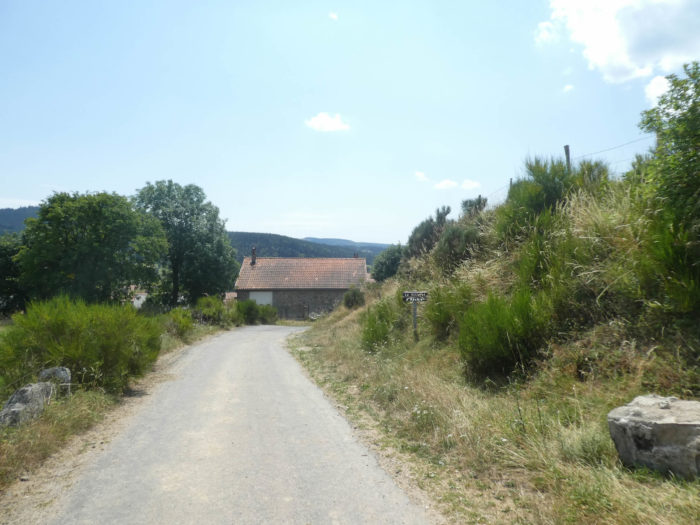 |
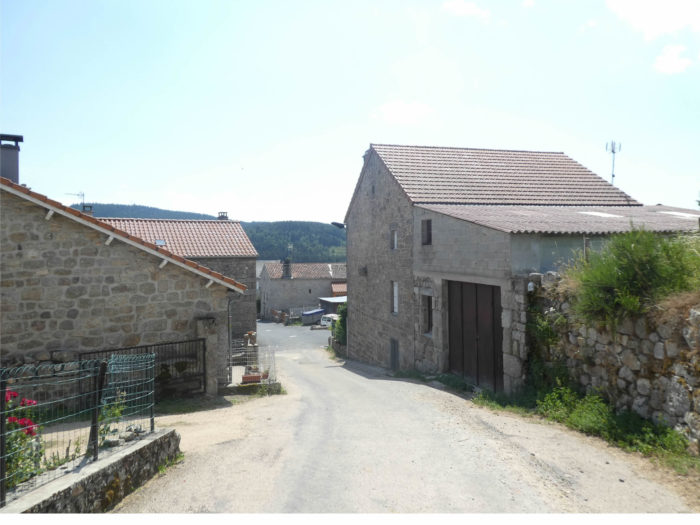 |
| In these villages, you sometimes have the feeling that the houses are waiting for you, that they speak to you, ready to give the secret of their stones, which are joined with lime or mortar. They always seem to have been there. |
 |
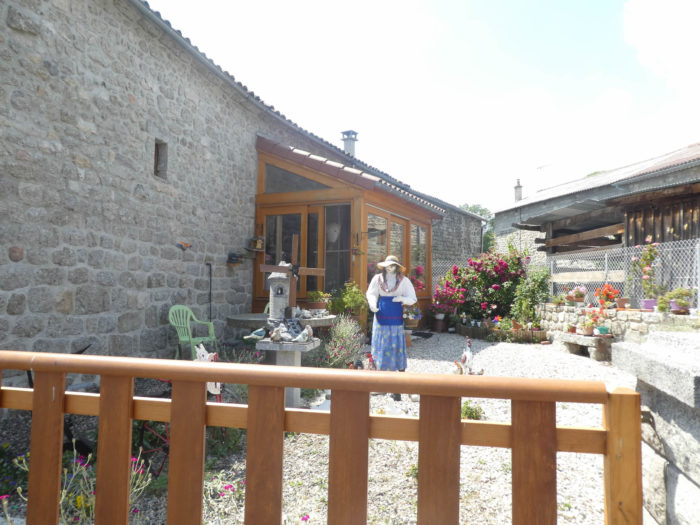 |
| At the exit of the village, at the end of some winding alleys, the GR65 steeply slopes down, more than 15%, on the tar towards the Virlange brook, which flows at the bottom of the village. It must be said that the road to Santiago offers surprises every day. It almost always run down to a river to climb afterwards. Without any profit meter. Be that as it may, today there is no severe descent nor demanding climb, just a few miles of undulating countryside and shady woods. |
 |
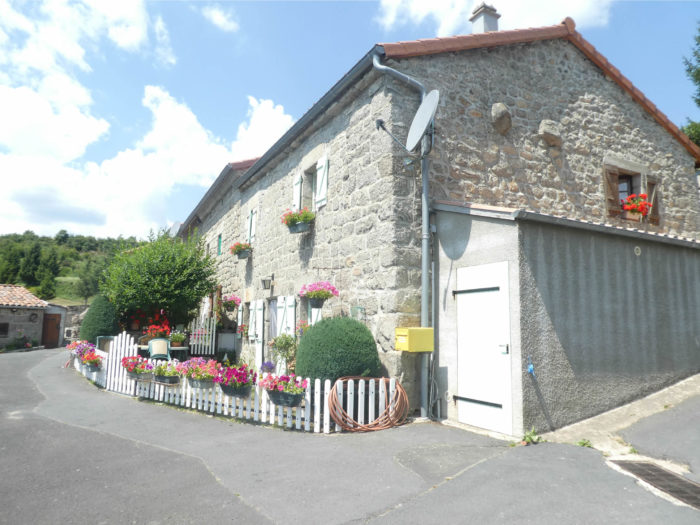 |
| The slope is steep along the low granite walls to the bottom of the village. Below the village flowed a spring which, it was said, healed the sick. It had to heal a lot, because since it has dried up, or at least the pilgrim who passes cannot find trace. When you’ll walk here, investigate to solve this puzzle. |
 |
 |
| The GR65 runs still a few steps on the tar in a small plain before crossing Virlange brook. |
 |
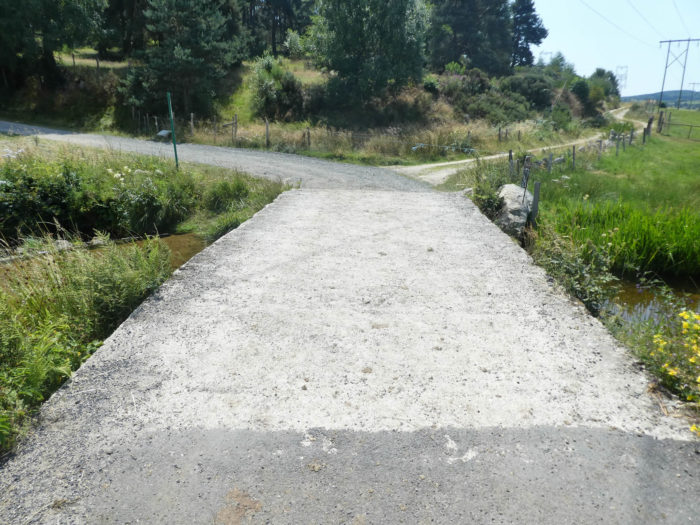 |
As you turn back, beyond Abundance cows in the meadows, you can still enjoy the charm of these stone villages hung on the hills.

| Quickly beyond the stream, the GR65 steeply climbs back on a wide dirt road. |
 |
 |
Section 4: On the hillside towards Le Sauvage.

General overview of the difficulties of the route: light sloping in general, except some more pronounced, but short slopes.
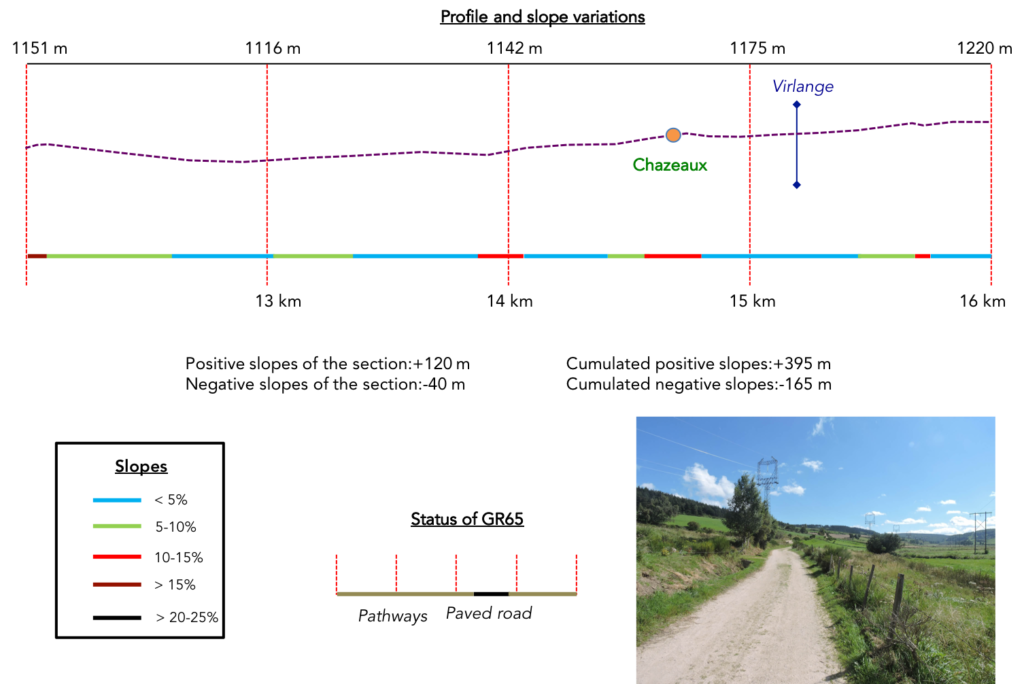
| There is a small steep hump in the forest of Ronc d’Estandard, in the middle of hardwoods, conifers and bushes. |
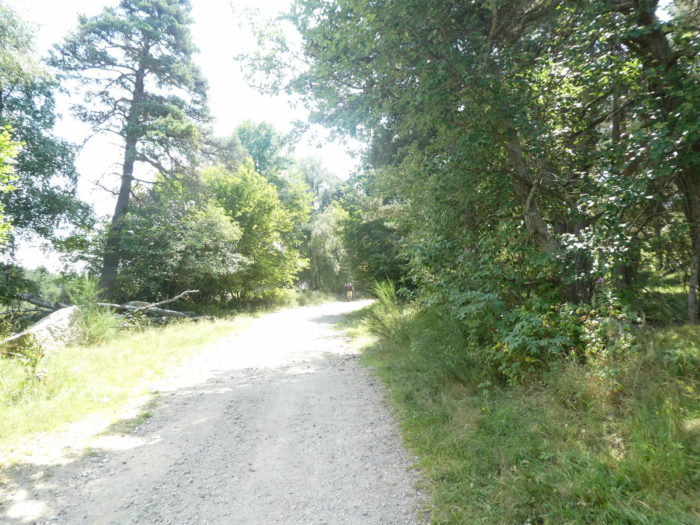 |
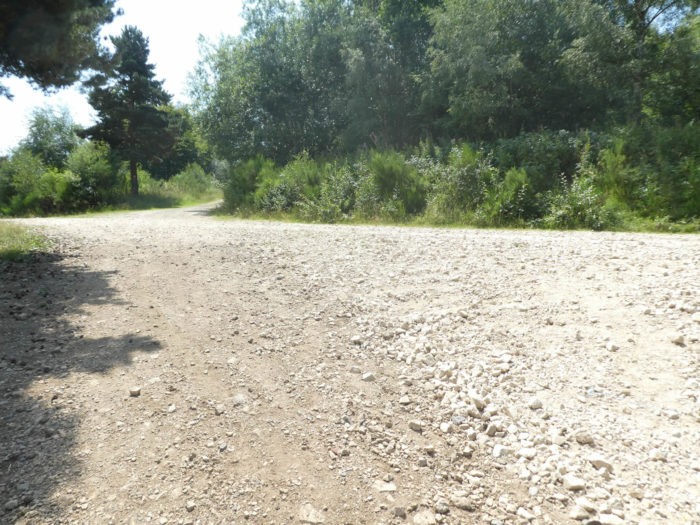 |
| The climb is not very long, and the pathway gently slopes back down the hill. |
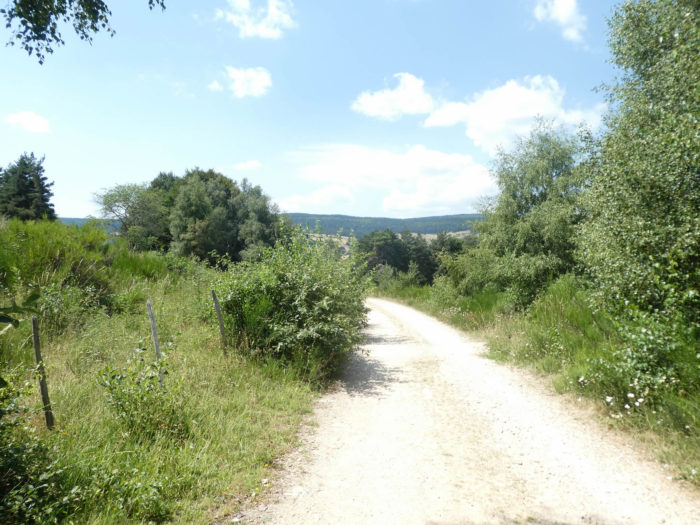 |
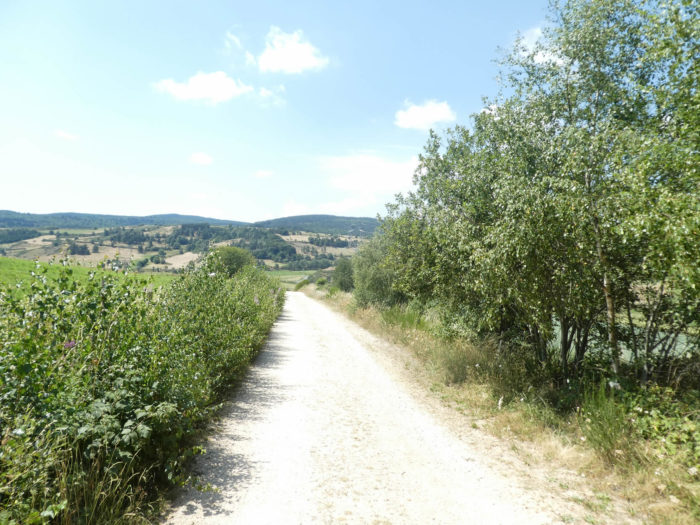 |
| Large, lanky metal giants dot the countryside. The disappearance of these giants is not for tomorrow. France has no money to bury its electricity underground. But, these high voltage lines, they will never put it underground. So, let’s live with, let’s curse them. In any case they serve as a point of reference for the pilgrim. The last pylon on the mountain is at the height of Le Sauvage, up there where he must go. |
 |
 |
| At a place called Le Moulin du Pin, the pathway climbs up the hillside again. |
 |
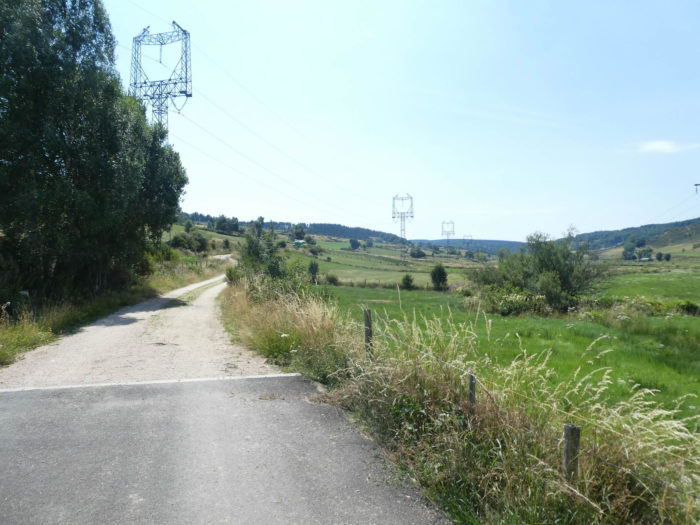 |
| For nearly a kilometer, the dirt road will gently slope uphill towards the bottom of the plateau, in the countryside. Chanalleiles village is approaching on your right, where the D589 road runs from Saugues to St Alban-sur-Limagnole. |
 |
 |
| Then the pathway slopes down back a little. The GR65 reaches a place known as Contaldès on the tar. You can reach the village of Chanaleilles, close to. |
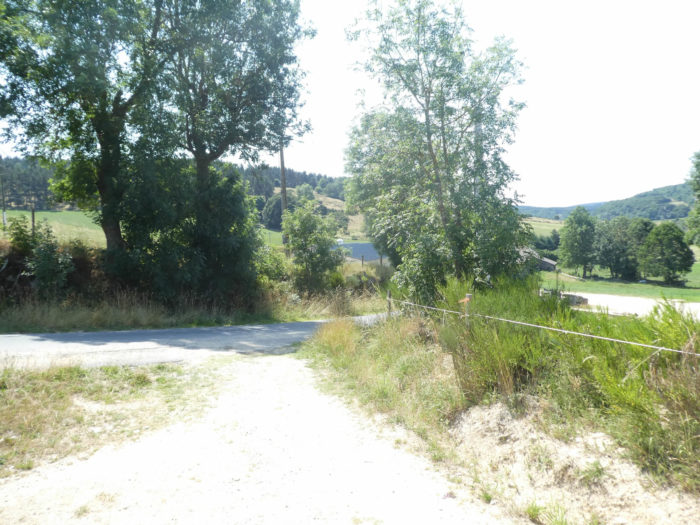 |
 |
| It is not because the gaze for many minutes dives on the graveyard outside the village, it is mainly because a grocery store and a restaurant that is also a gîte are present. The church with its comb tower is remarkable. The comb tower is a single wall pierced with one or more openings for bells. In these open bell towers, the bells in the open air are suspended in the sky and emit sounds filled with frankness and clarity. |
 |
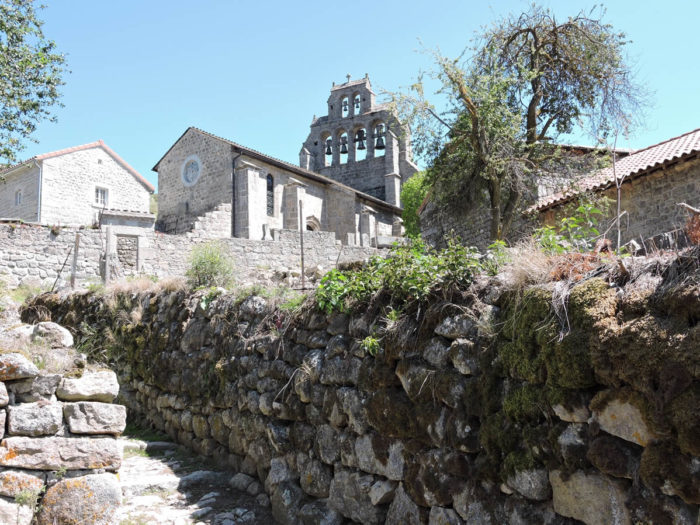 |
| Beyond Contaldès, the dirt road takes its rights again and climbs along the undergrowth of ash trees in the hornbeam bushes and brooms. The slope is again more sustained in places. |
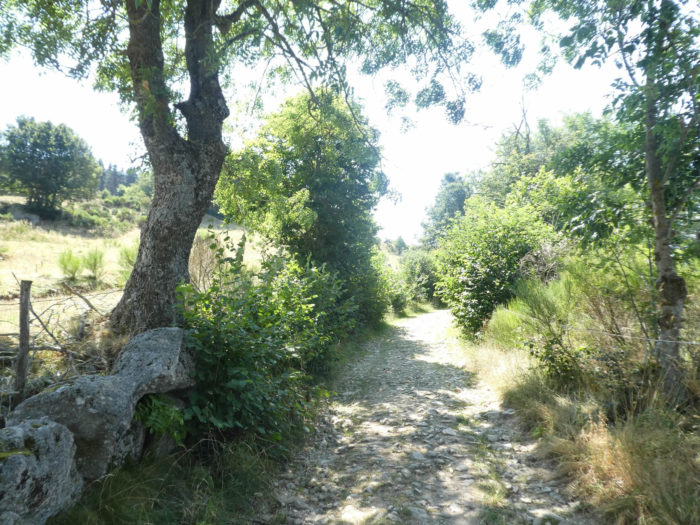 |
 |
| Further up, the pathway soon gets to Chazeaux village. |
 |
 |
| Chazeaux is a pretty little stone village, as are all the hamlets in the area. Many pilgrims stop here to eat before facing the last climb to le Sauvage. The fullness of a house restored with love, what more does the pilgrim demand? |
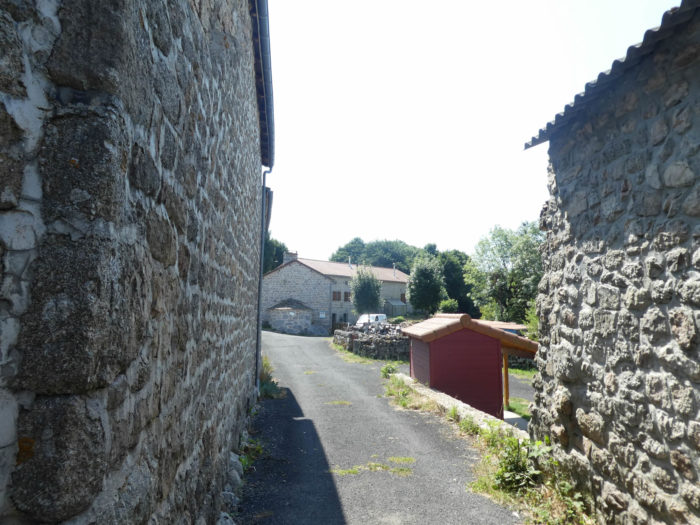 |
 |
What a pleasure to meet in these villages with strong houses these small squadrons of hens that sport freely!

| A steep road comes out and runs over the village. |
 |
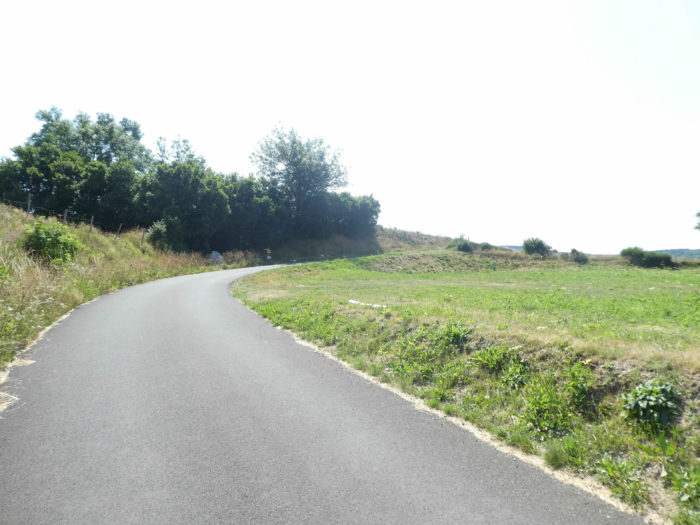 |
|
Little above the village, the road reaches a place called La Sagne, at 1170 meters above sea level, almost 5 kilometers to Le Sauvage. |
 |
| A dirt road then slightly slopes up in the broom towards the forest of Narcettes. |
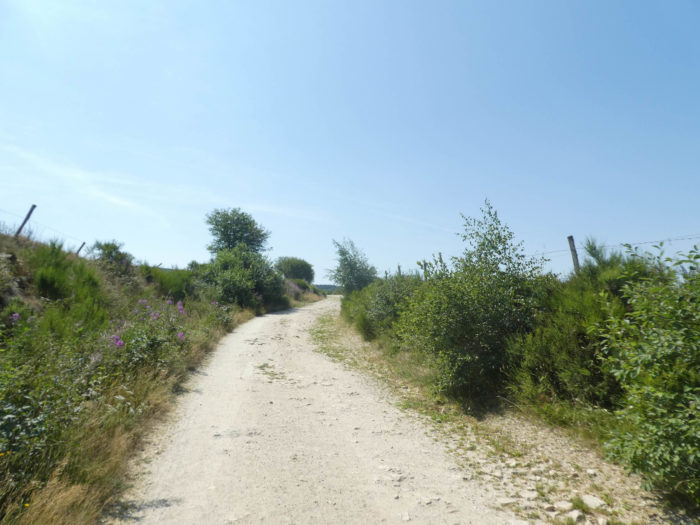 |
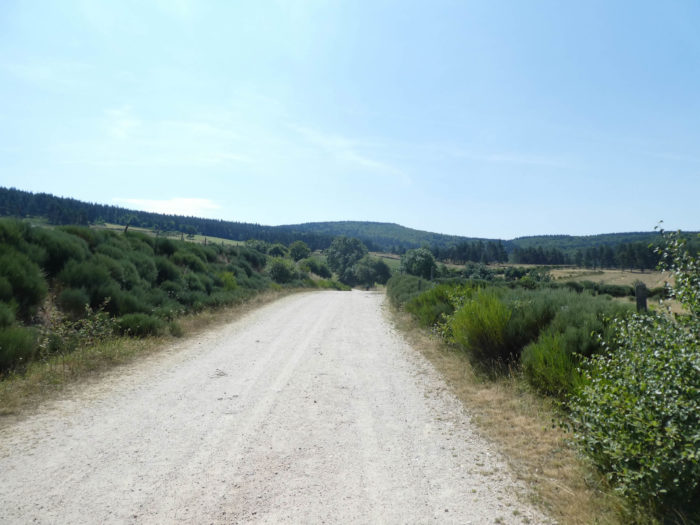 |
| The countryside is beautiful and sweet here, with sometimes a few pines and beeches, brooms, heather and blueberries. The spruces of the forest are soon to appear. |
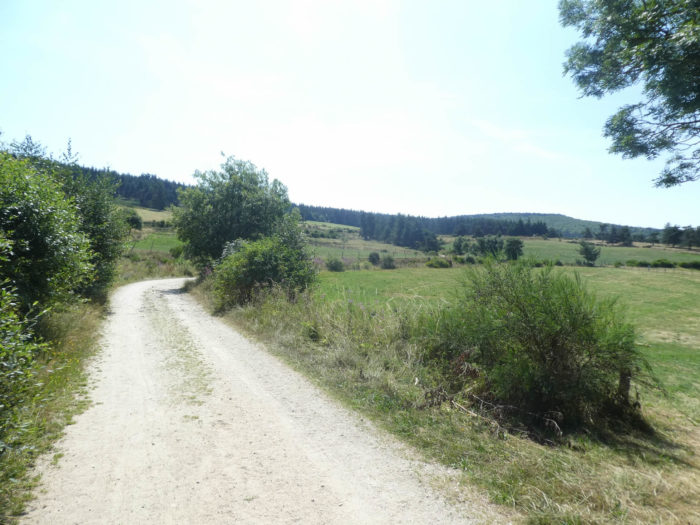 |
 |
Section 5: Up there, to Le Sauvage, which deserves its name.
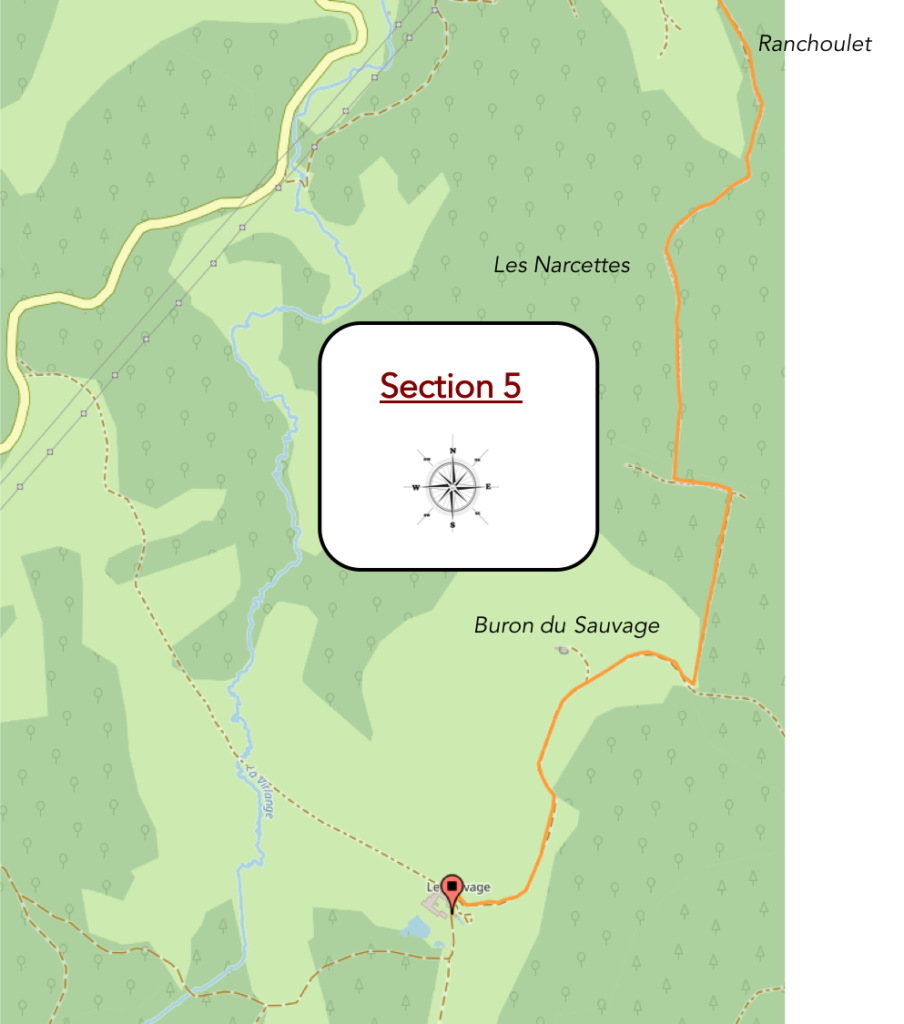
General overview of the difficulties of the route : to say that yo walk towards the mountain, climbing presents hardly any difficulties, if it is not some more severe slopes around Ranchoulet.

| The greenery of the meadows will then give way to the dark color of the fir stands, on a lane covered with coniferous needles, which hesitates between pebbles, humus and moss. The pathway sinks into the darkness of a new wooded dale. You’ll climb to the highest point of the day. The pathway zigzags between pines, beech trees and clear vegetation. Tight against each other, the trees barely let slip the tortuous lane that leads to the high plateau. At a place called Ranchoulet, the track enters the forest, leaving the wide dirt road for a narrower forest pathway, which is twisted along the ridge, in the middle of beech and coniferous trees. |
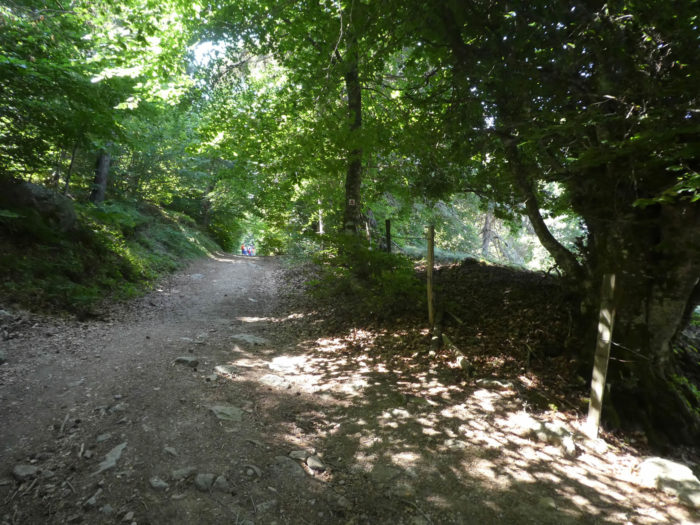 |
 |
| At the edge of the wood, a first barrier to contain livestock appears. |
 |
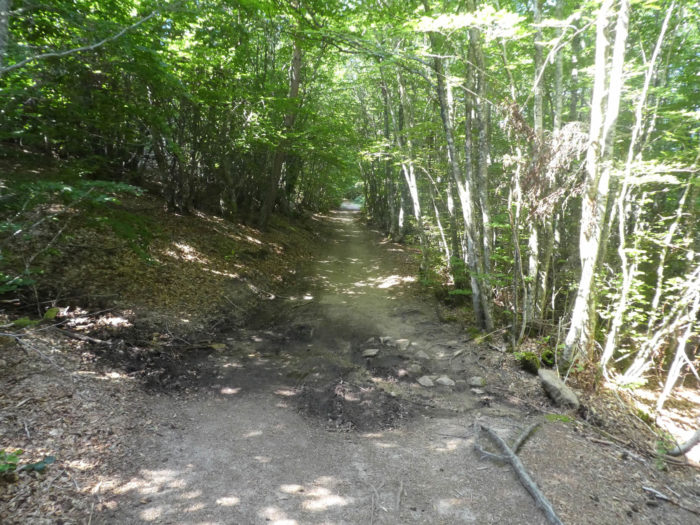 |
| The forest is mainly divided between beeches, hornbeams and pines, which make hedges fairly dense. |
 |
 |
| The pathway, sometimes a little stony, twists in the forest, direction Buron-du Sauvage. I’s quite easy, sometimes a little steeper. |
 |
 |
| Further up, the slope is softer in clearings that make light gaps defining havens of tranquility and serenity, among the bunches of pines. |
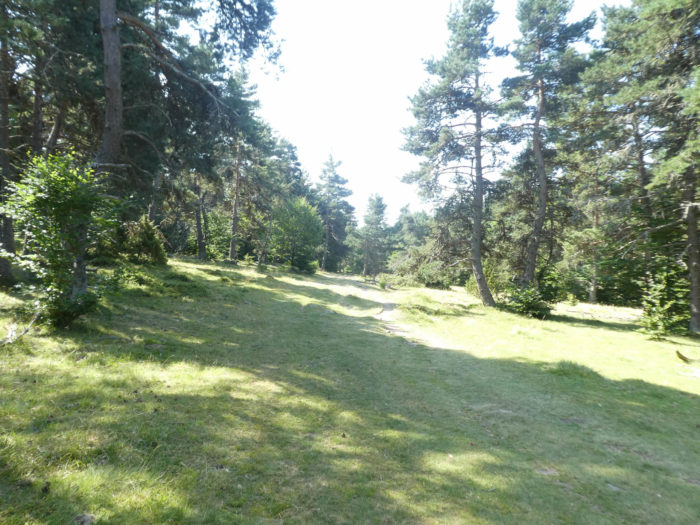 |
 |
| A second barrier cuts the horizon off, that must be carefully closed after its passage because the cattle are present here, with beautiful Aubrac cows. |
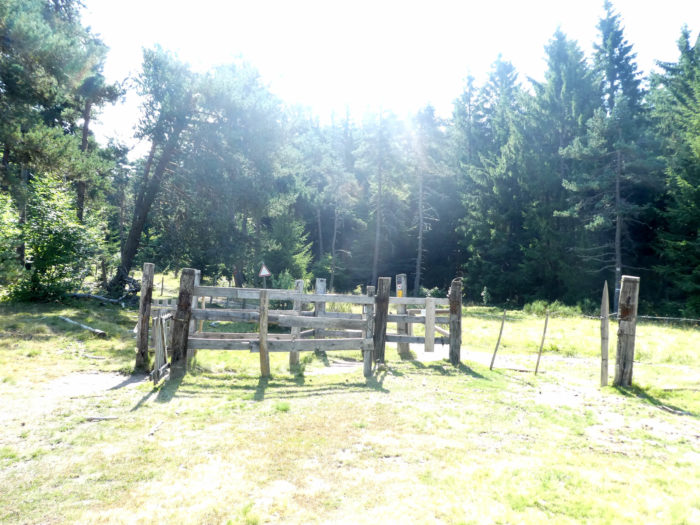 |
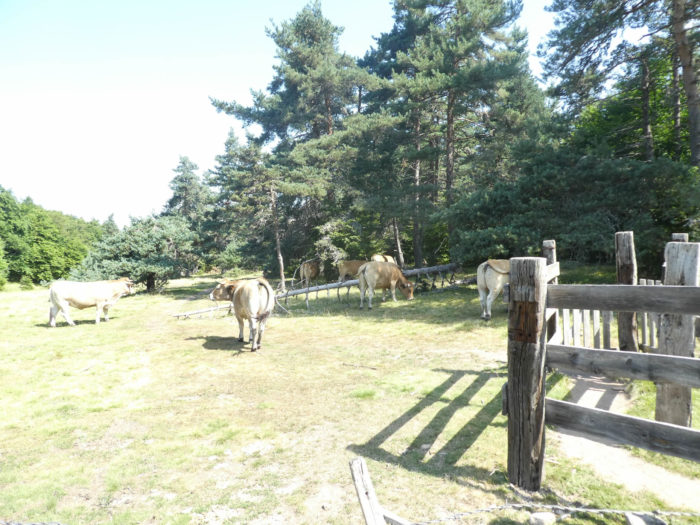 |
| Shortly after, a broad, slightly stony pathway, bordered with pines tortured by the winds, sculpts a land that hesitates between brown and ocher. It continues to climb, zigzagging in a beautiful forest. The forest, at first a mixture of hardwoods (mostly beech) and conifers, soon turns into a denser forest where pines mingle with spruce. |
 |
 |
You have reached an altitude that allows the spruces to proliferate. They grow, tight and straight against the heights and reach incredible heights. The forest is beautiful here. To believe that trees make a race towards the sun.
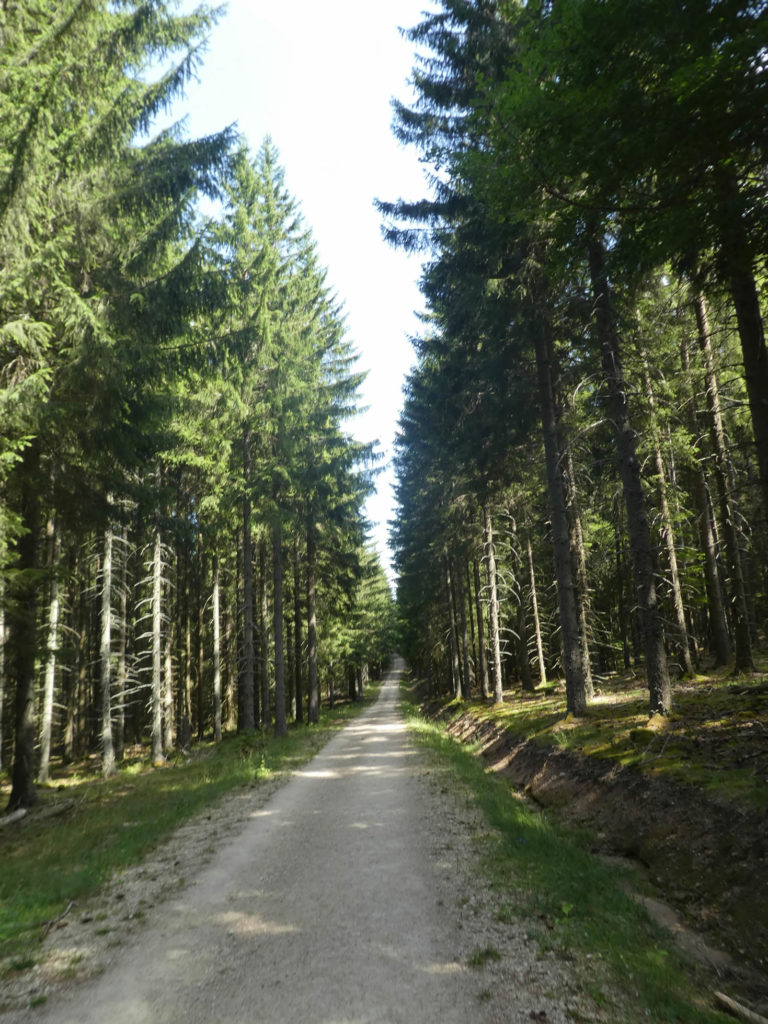
| Soon, the forest lane comes out of the wood, opens on the high plateau like a window on the top of the mountain, in the grandiose beauty of the Domaine du Sauvage, which you guess, one kilometer further. |
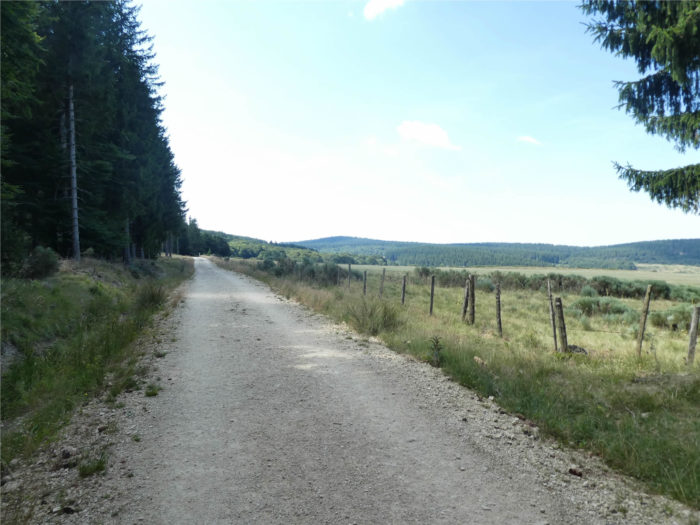 |
 |
| You reached a place known as Buron du Sauvage, 1320 meters above sea level, the highest point of the stage. The Sauvage appears on the horizon as a small point lost in a huge pasture clearing. |
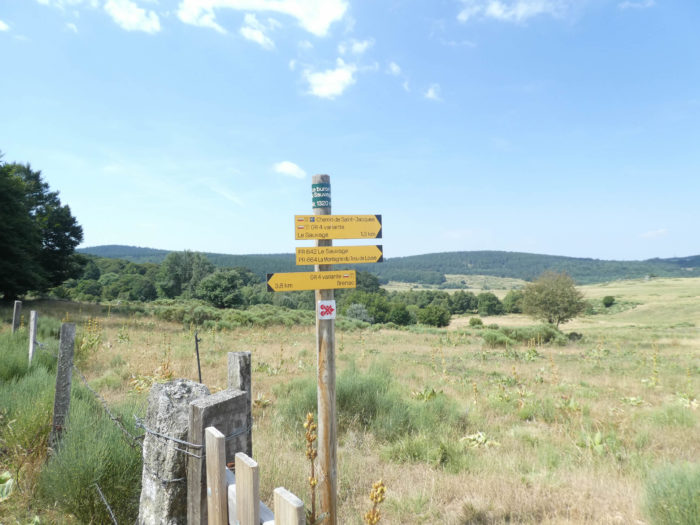 |
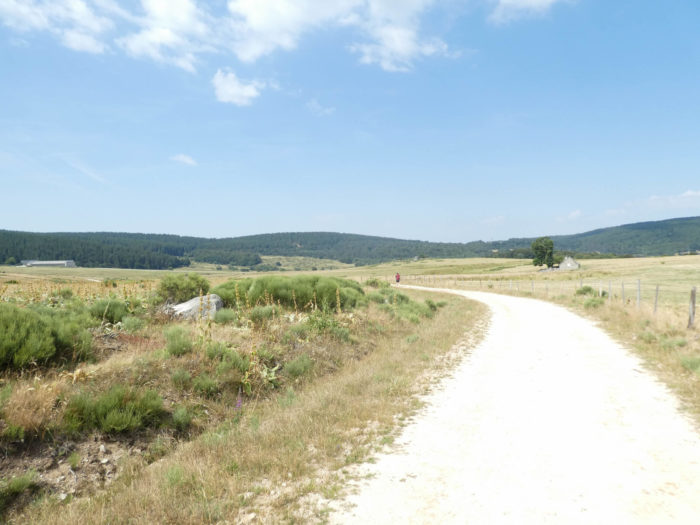 |
| There are endless pastures where graze Aubrac cows, little frightened by the pilgrims they see every day moving. |
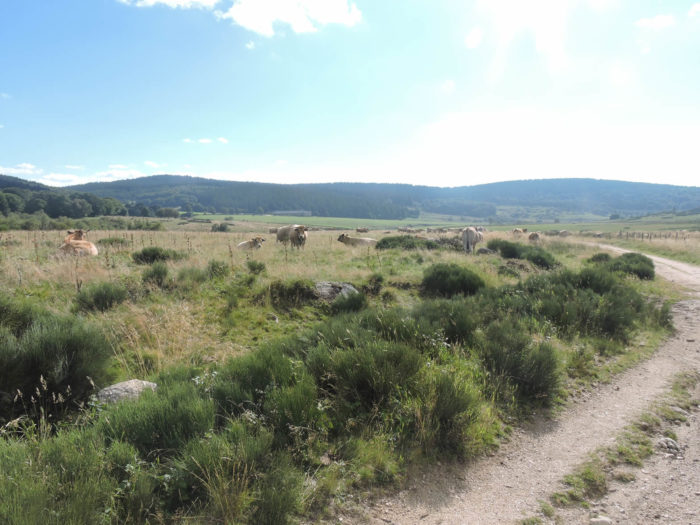 |
 |
How beautiful these cows are …
Wait for the video to load.
| A wide dirt road crosses the vast pasture, behind the “buron”. The “buron” are stone shepherd huts, characteristic of the region. These are now only beautiful landmarks sown in the landscape. |
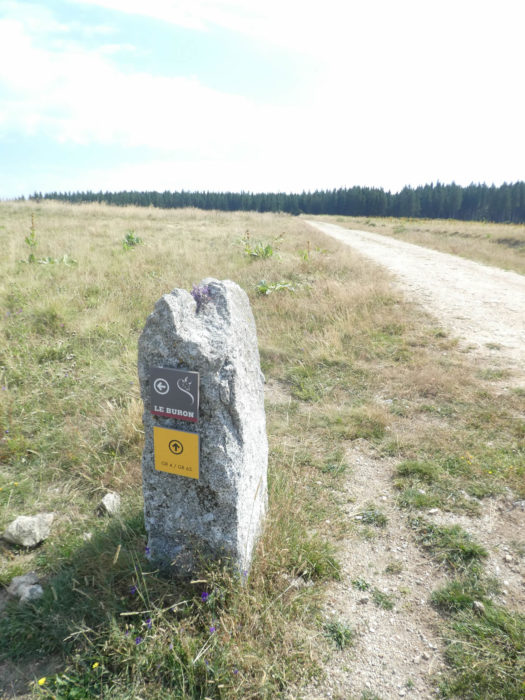 |
 |
The small dot on the horizon is growing fast enough to suggest a massive group of stone buildings. From a distance, it looked like a farm, but up close it’s a fortress. The Sauvage, seldom said to have been so judiciously baptized. Like the island of the shipwrecked, it emerges in the middle of nowhere, in a gigantic pasture surrounded by immense forests. The Sauvage is a fortress, but a peasant fortress, the only human trace for miles around. But watch out! From Sauvage, he has only the name. Its soul is all made of comfort and human warmth.
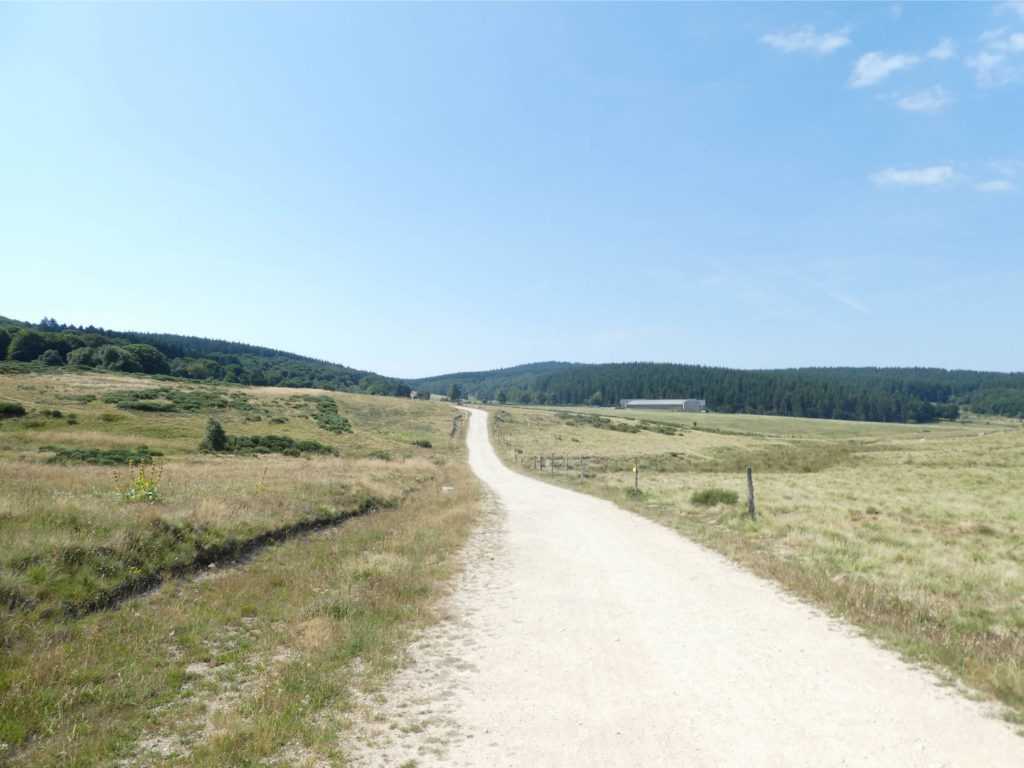
| Still a few hundred meters on the dirt road and the route arrives at the farm. |
 |
 |
| The Sauvage is located in the granite massif of Margeride, between the signal of Randon and Mont Mouchet. Granite is the base stone of constructions in Cantal, Lozère and Haute-Loire.
The farm occupies more than 800 hectares. Used a long time ago by the Knights Templar as a hospital, the domain has known many owners over the centuries. The current buildings date from the 18th and 19th century. Once promised a certain ruin, they are now managed by farmers. The buildings include the cottage but also farm buildings, ramps and a large square courtyard. You’ll eat and drink the products of the farm, in a beautiful common room that may have been the home of the Templar Knights. |
 |
 |
| The Sauvage has been used for all times as a centre for pilgrims. Yes, you must stop here, there is little doubt, if you have booked on time. Just below the reception, ducks paddle in a jewel of a small lake. Would we come back another day in this great place of solitude? |
 |
 |
Lodging
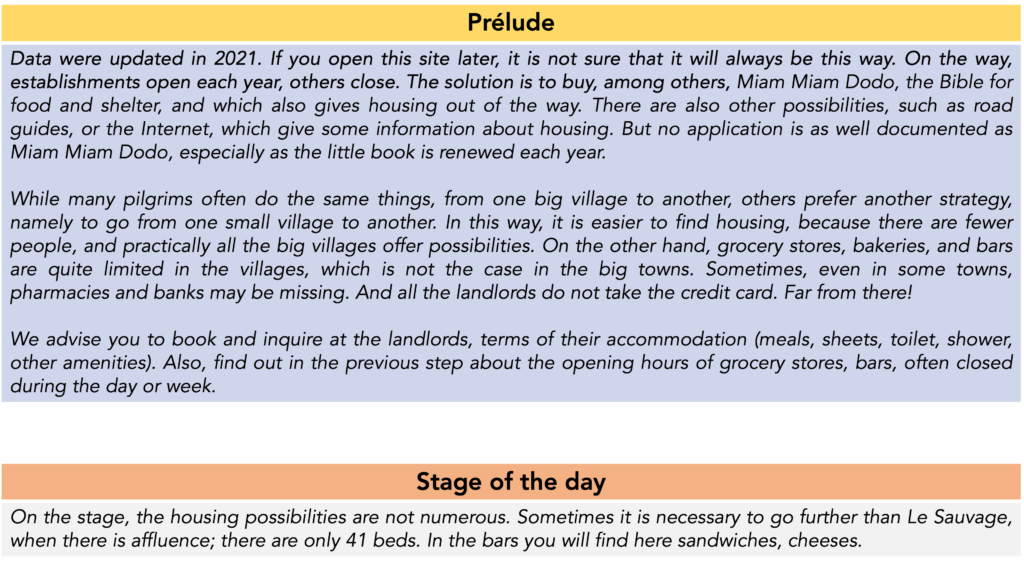
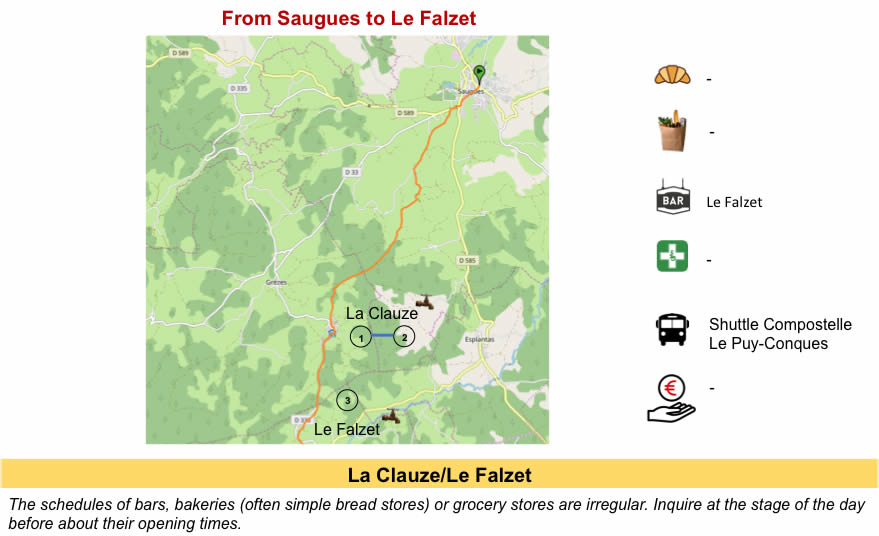
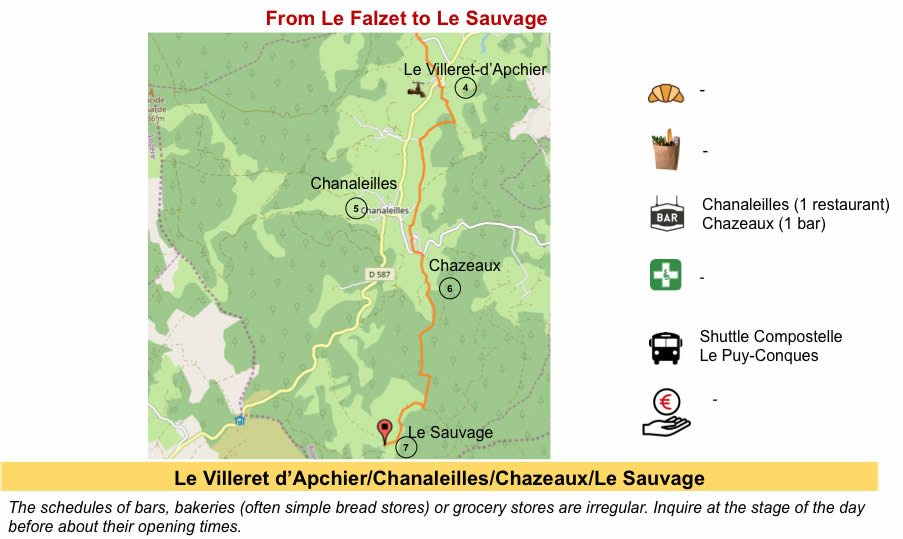
Feel free to add comments. This is often how you move up the Google hierarchy, and how more pilgrims will have access to the site.
|
 |
Next stage : Stage 4: From Le Sauvage to Aumont-Aubrac |
|
 |
Back to menu |



























